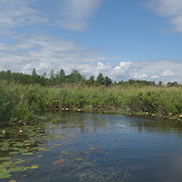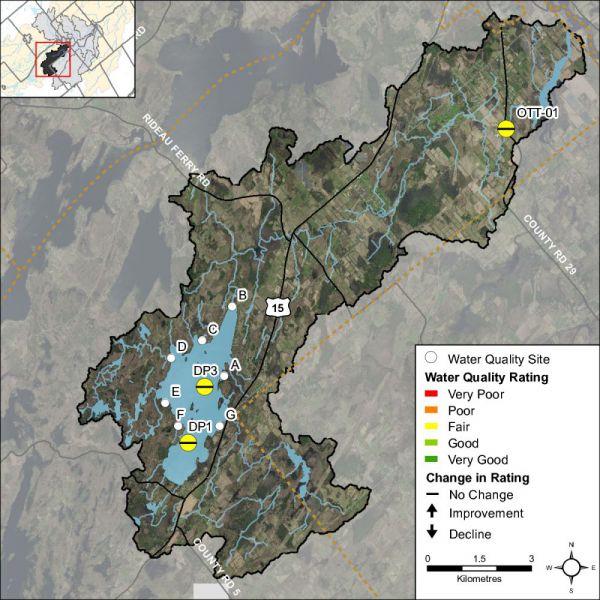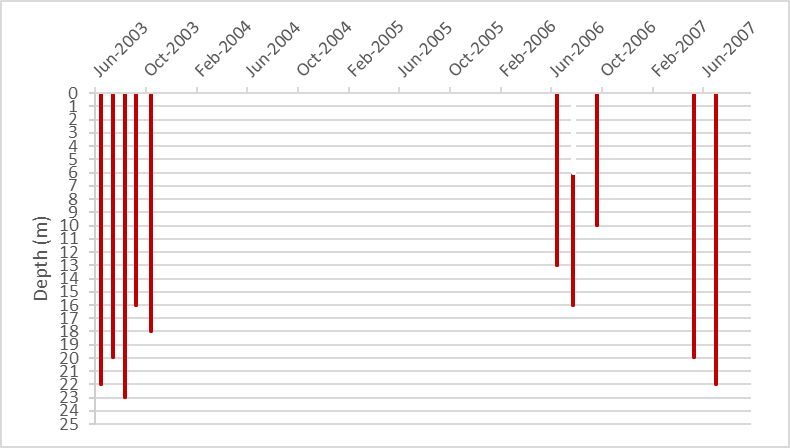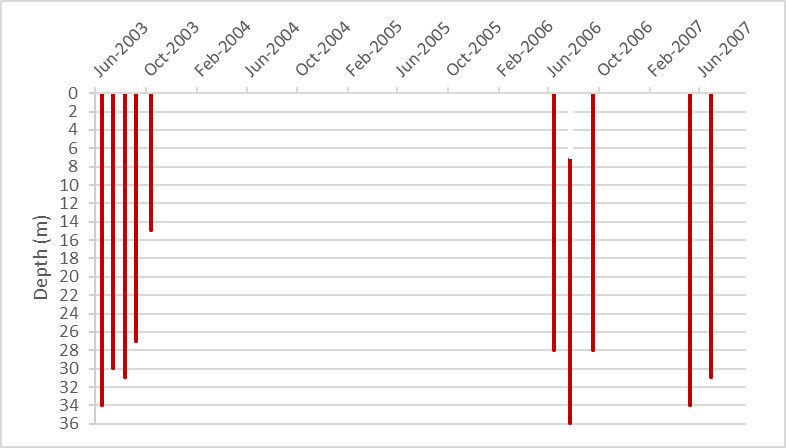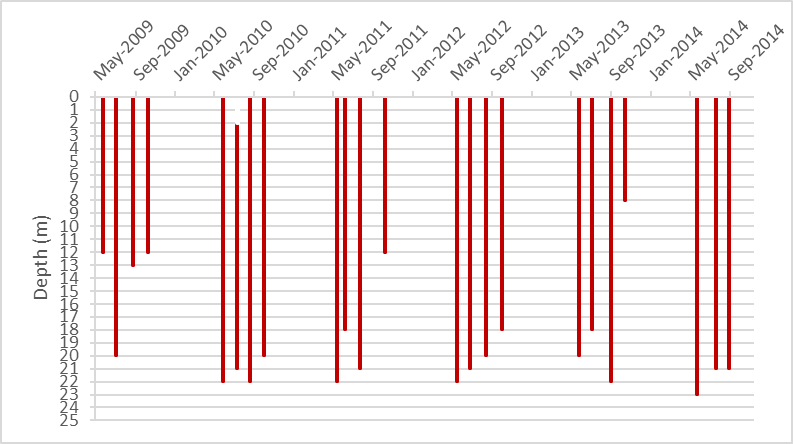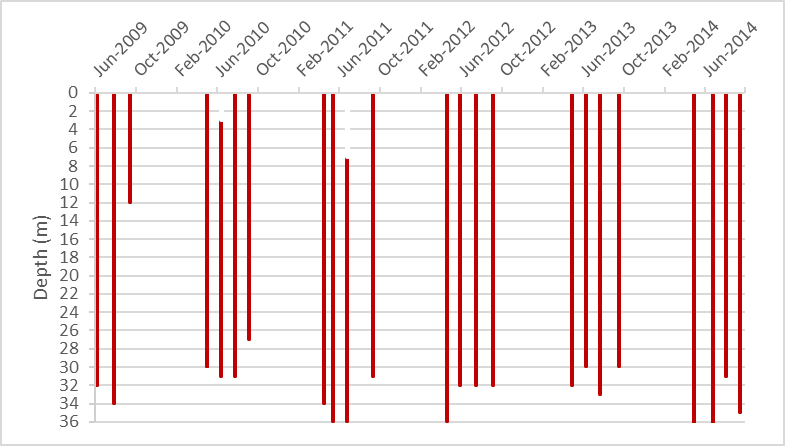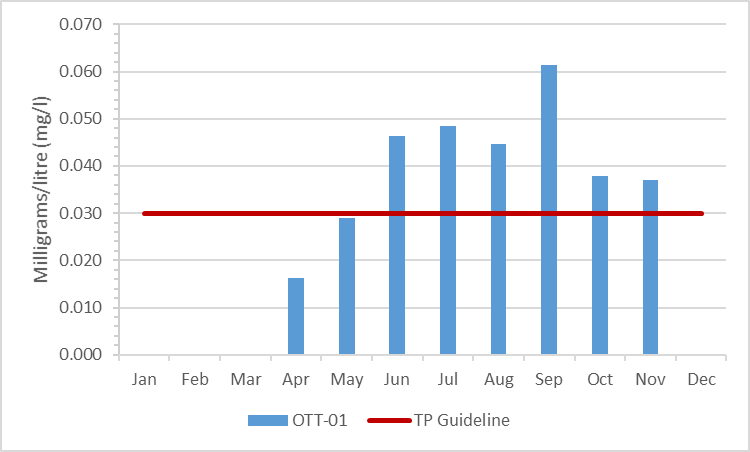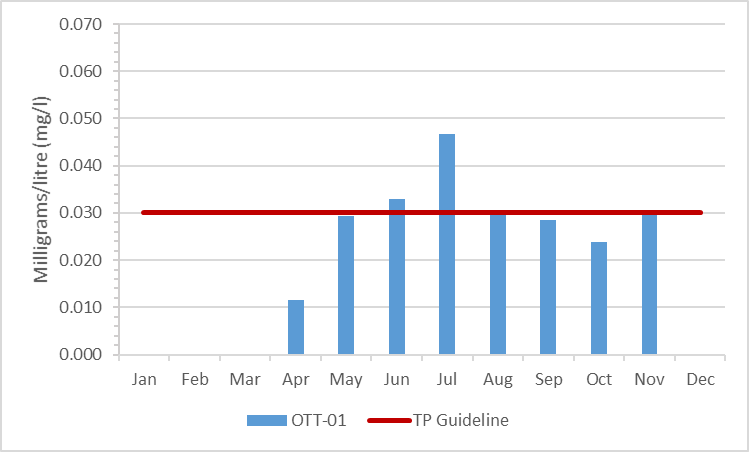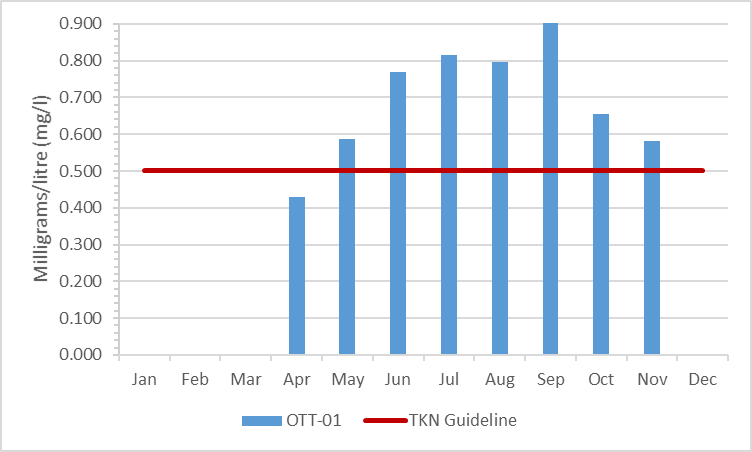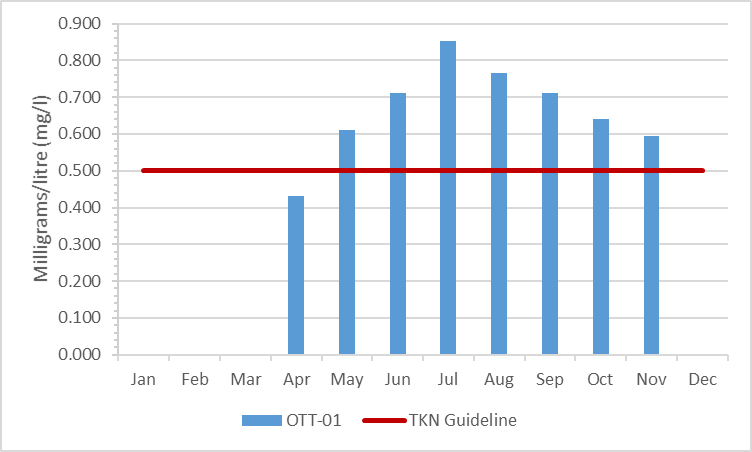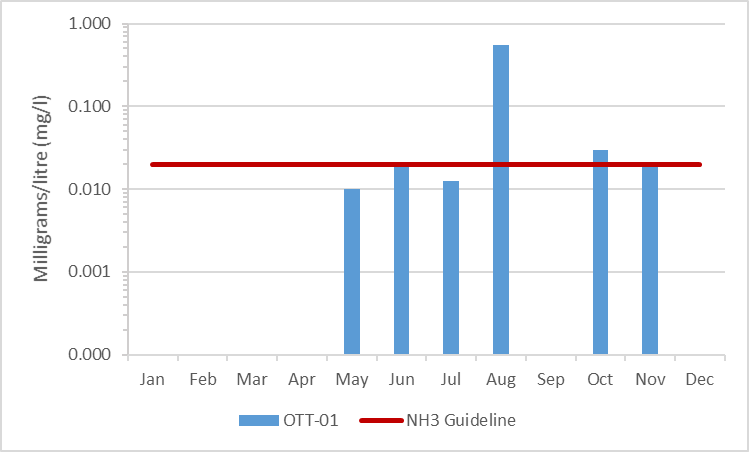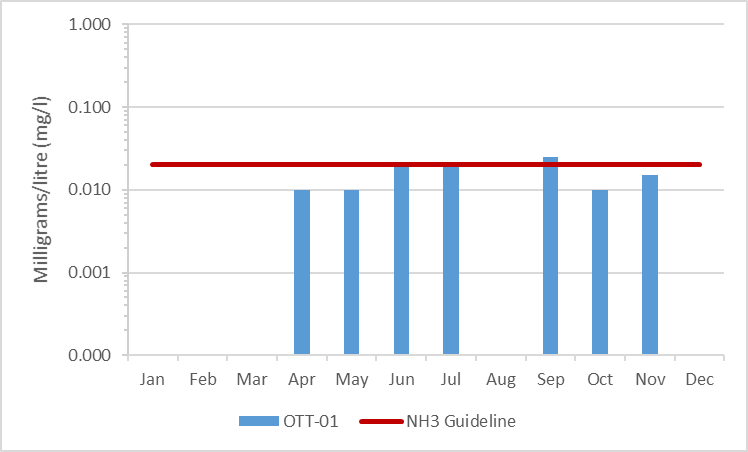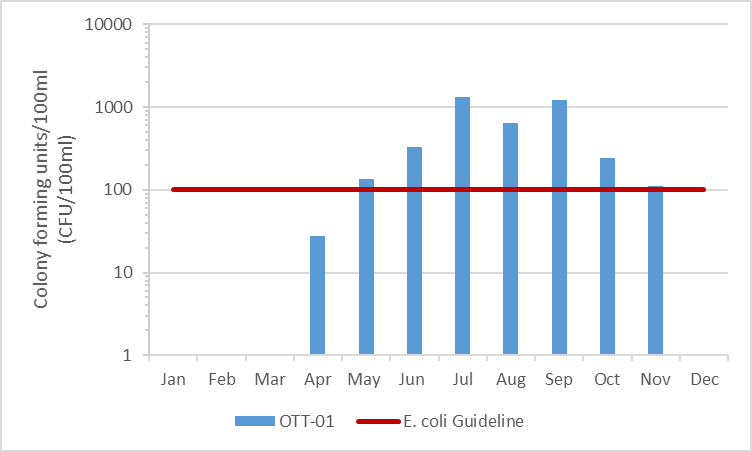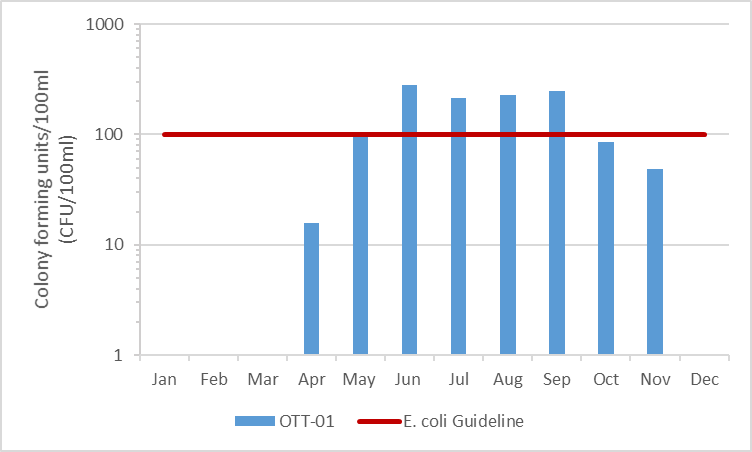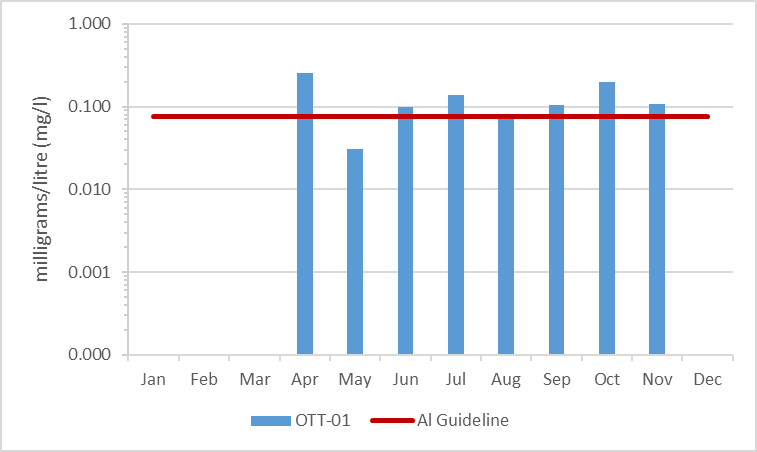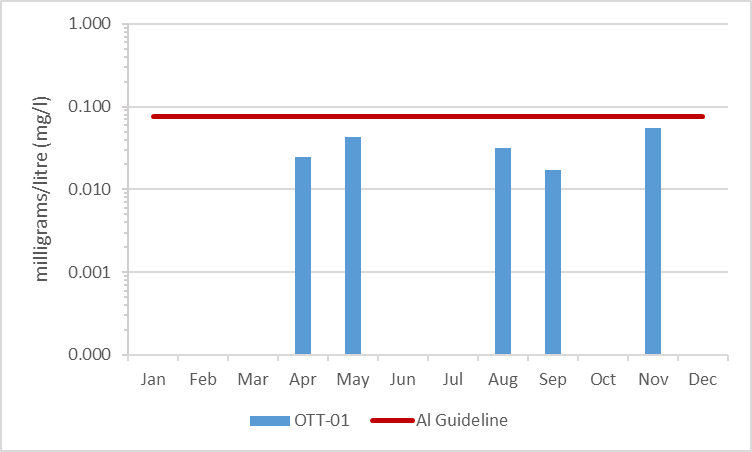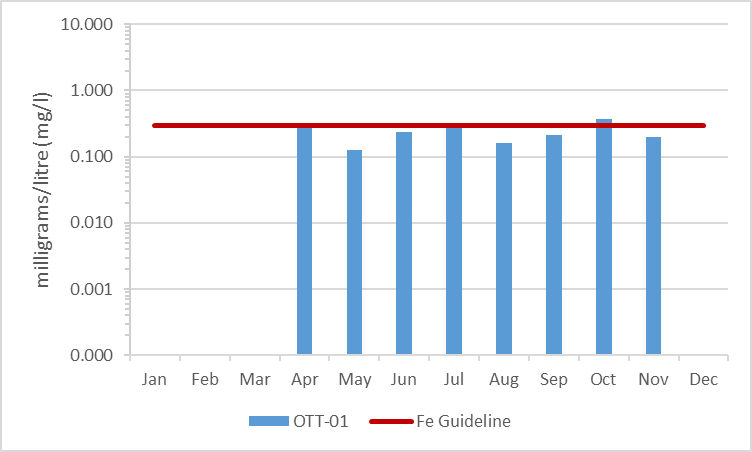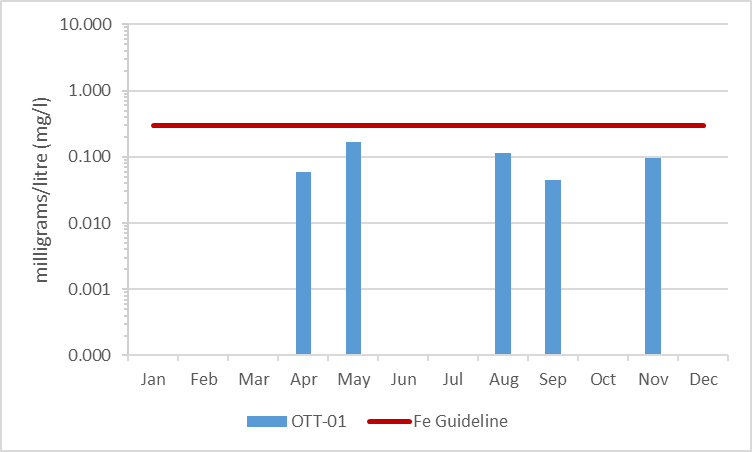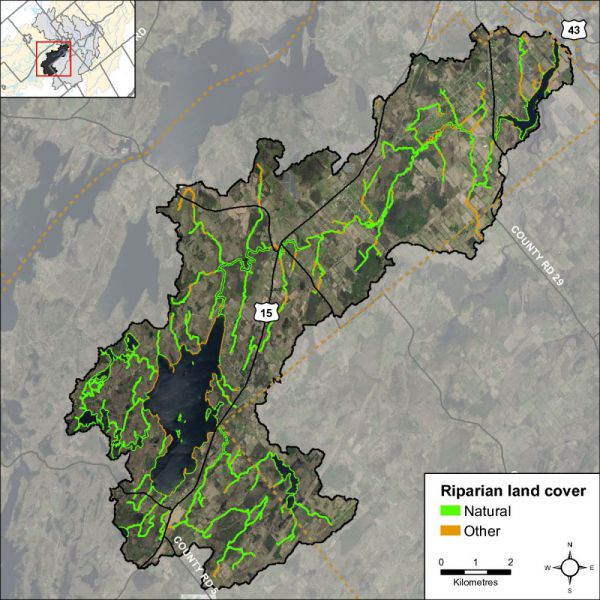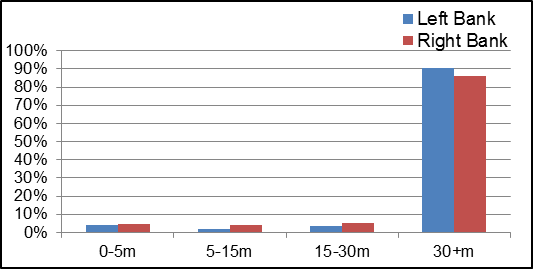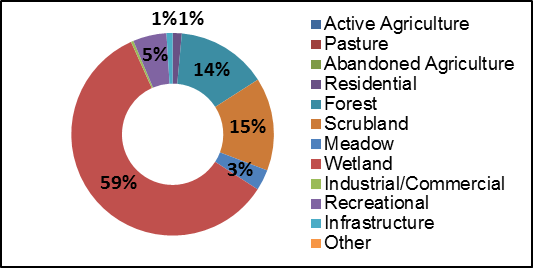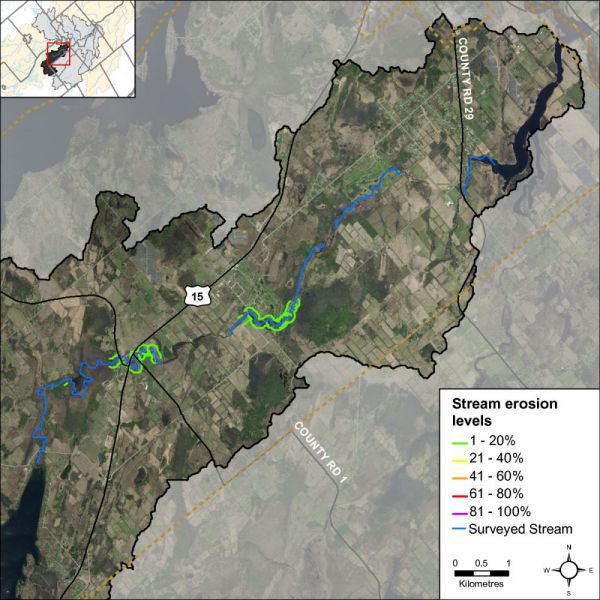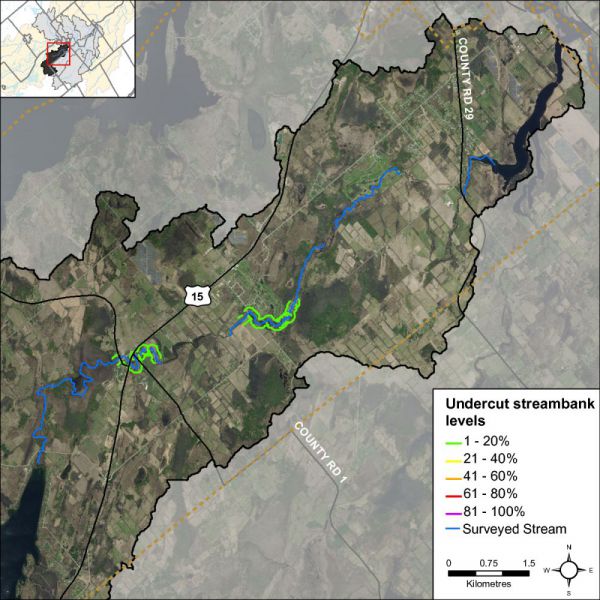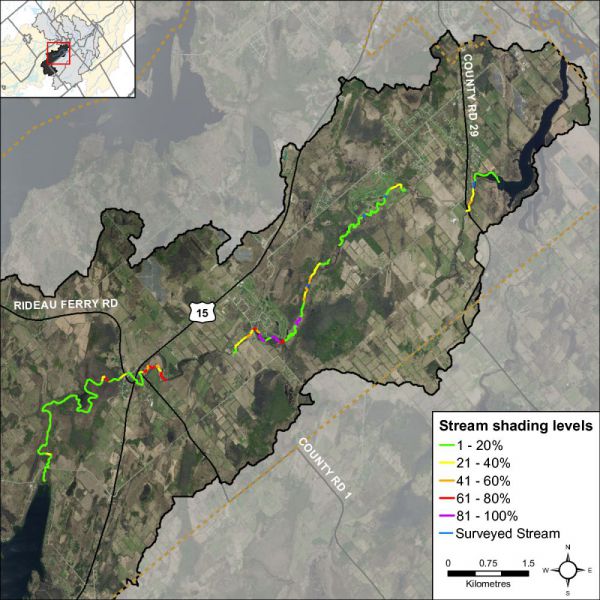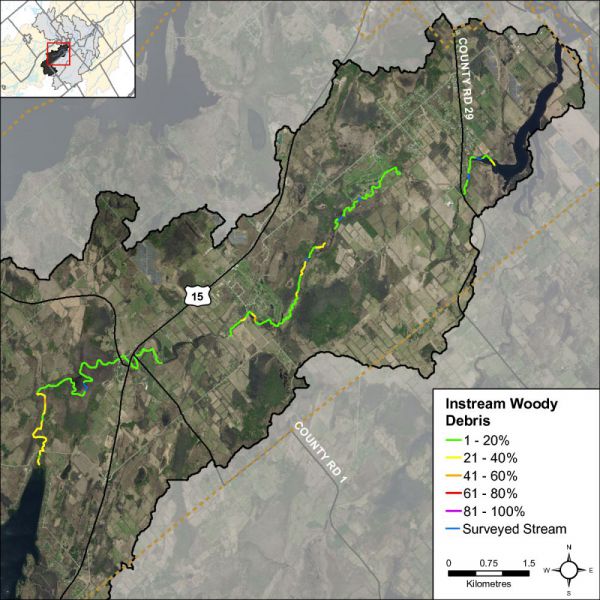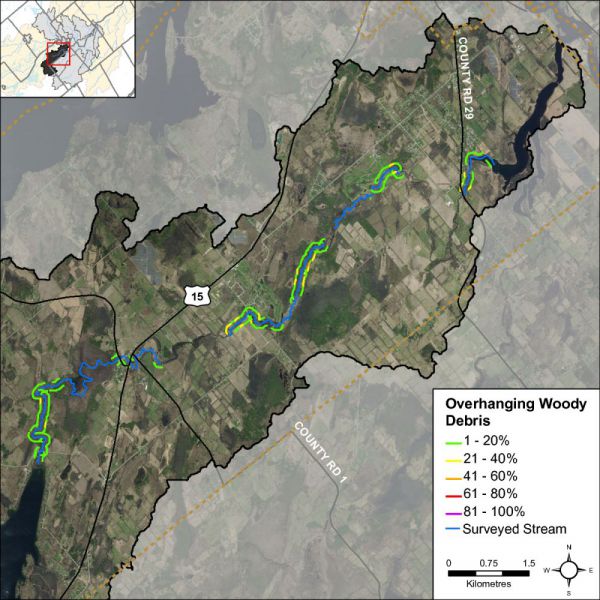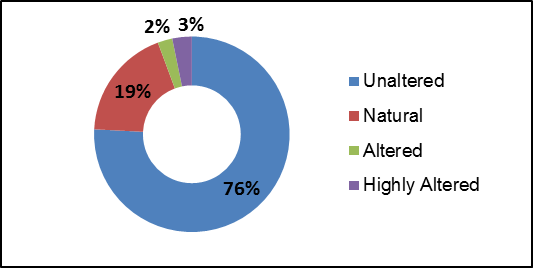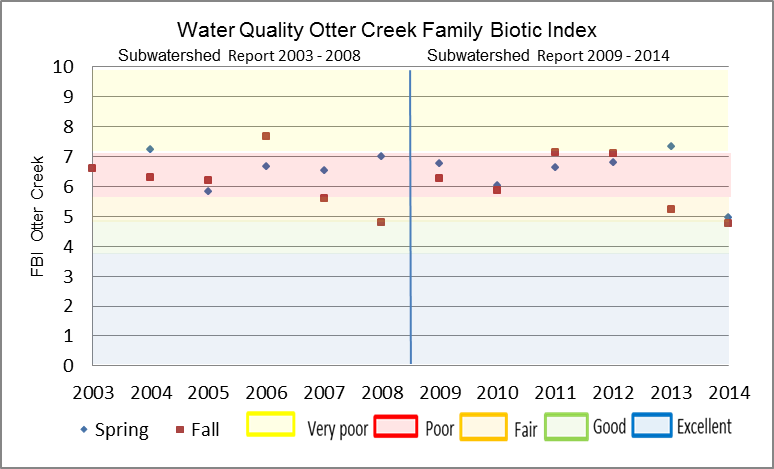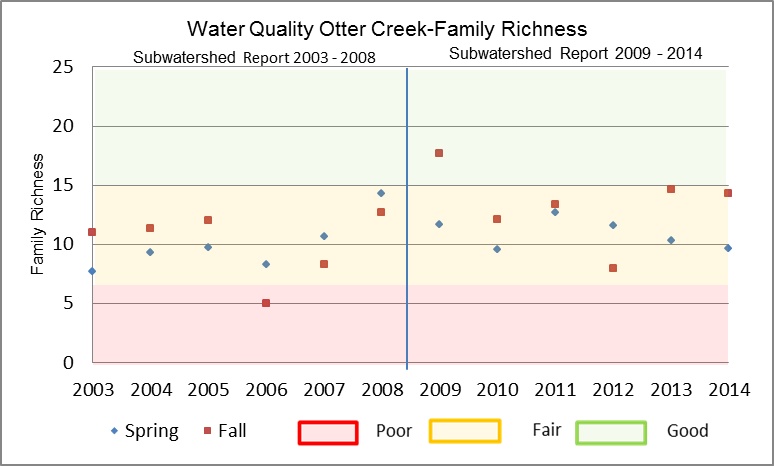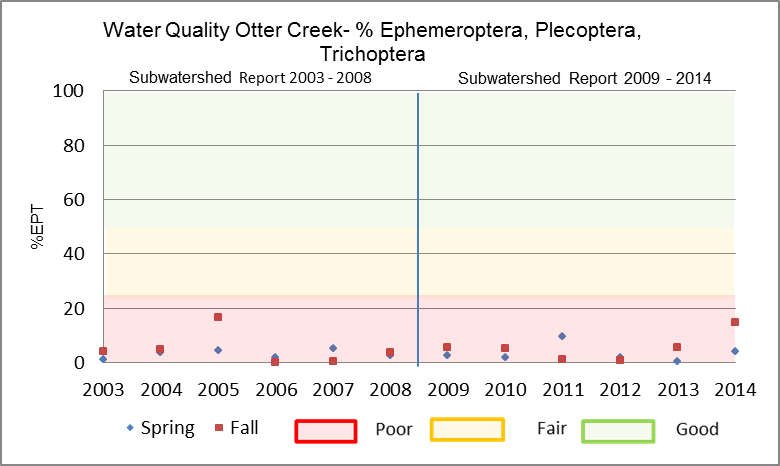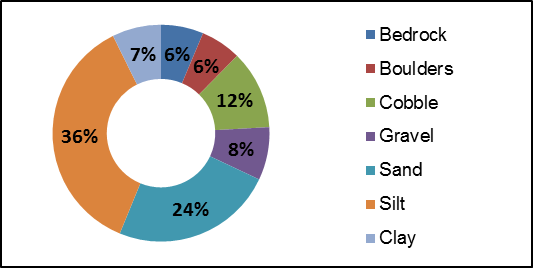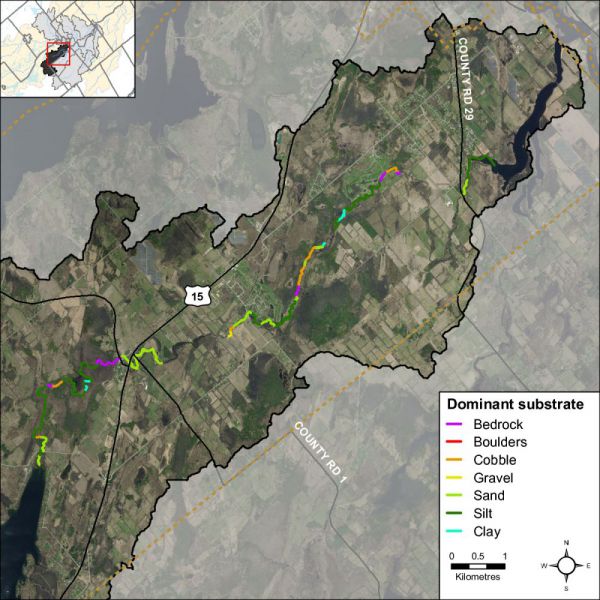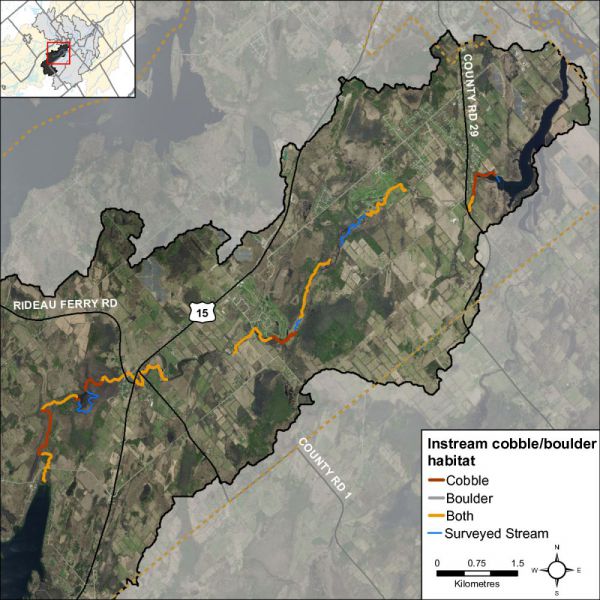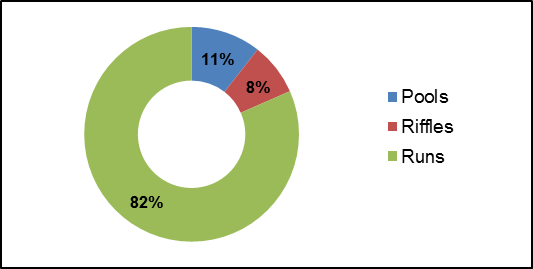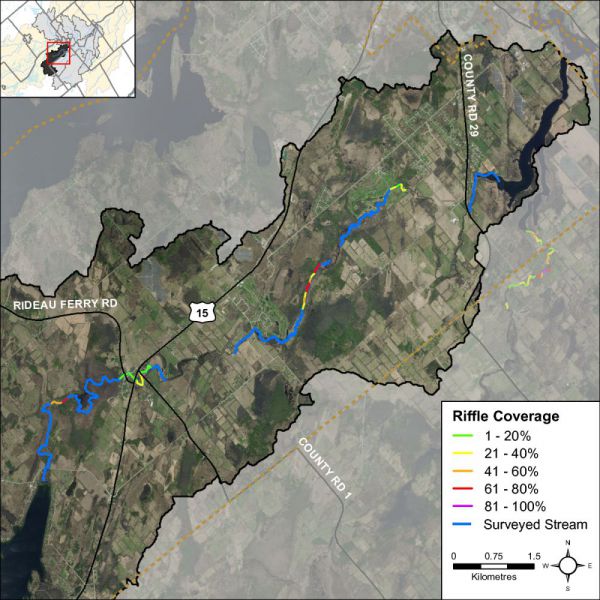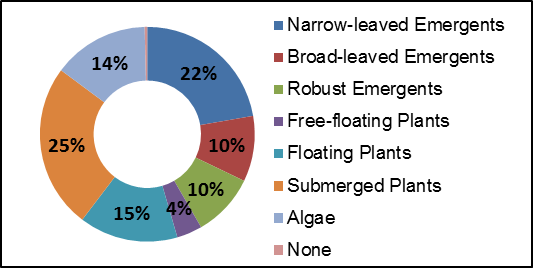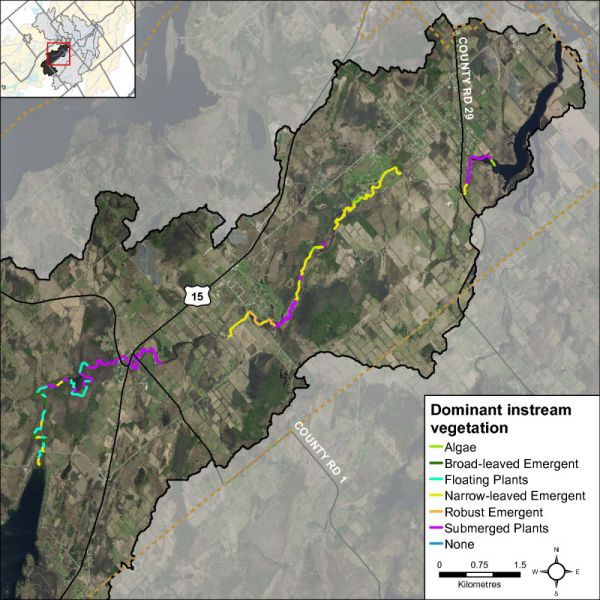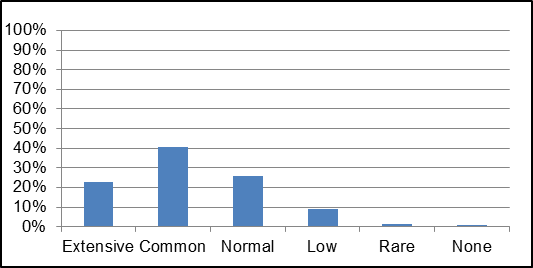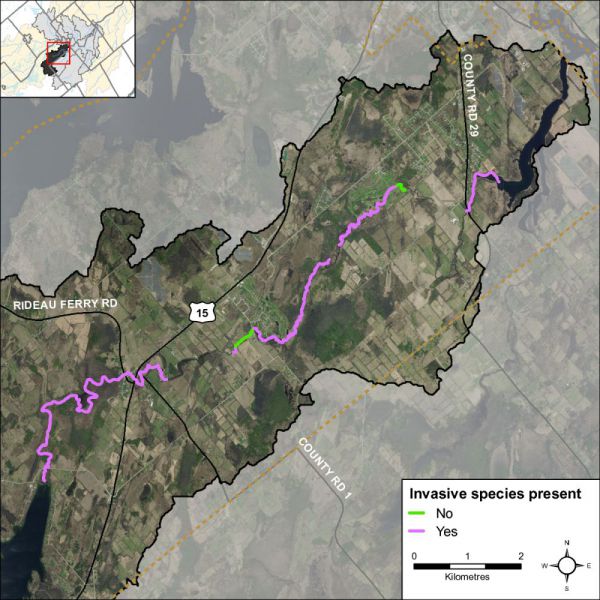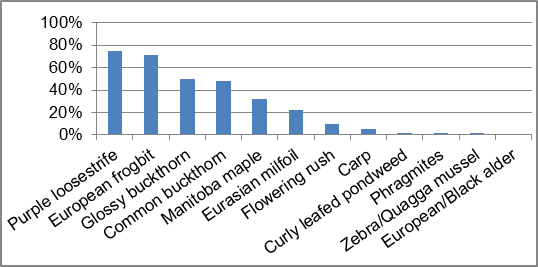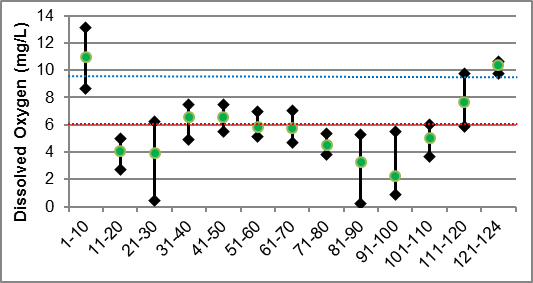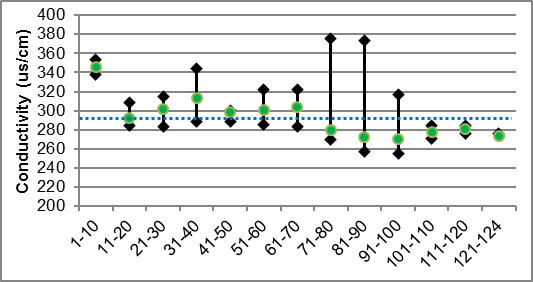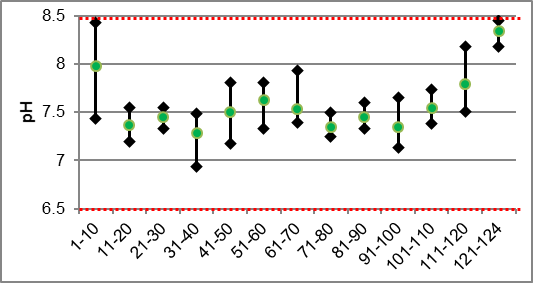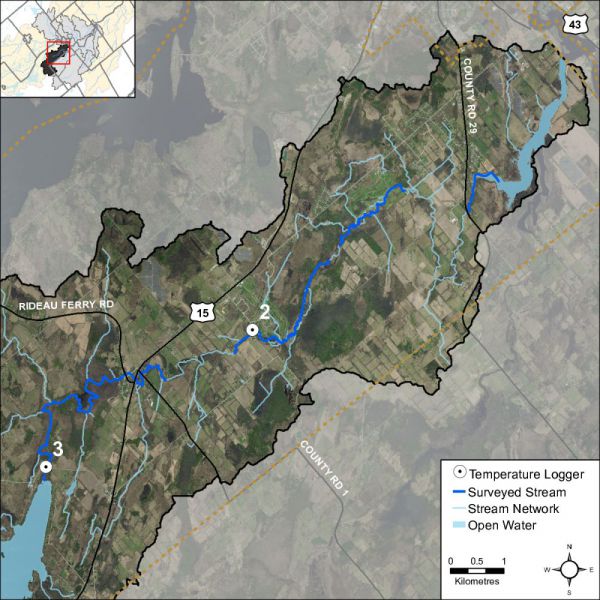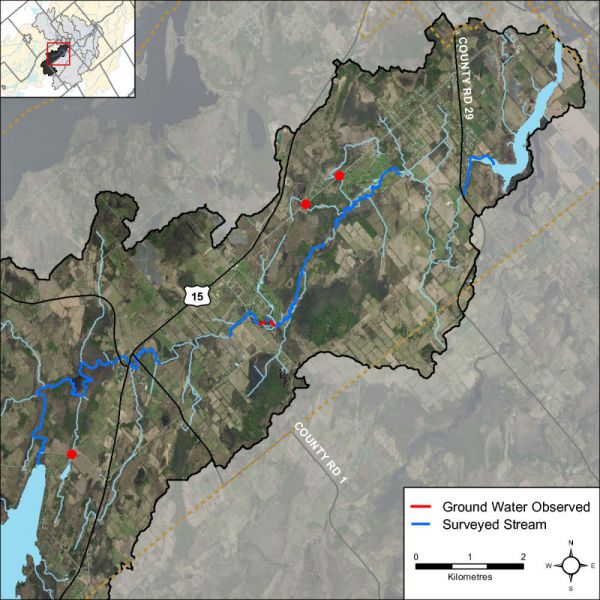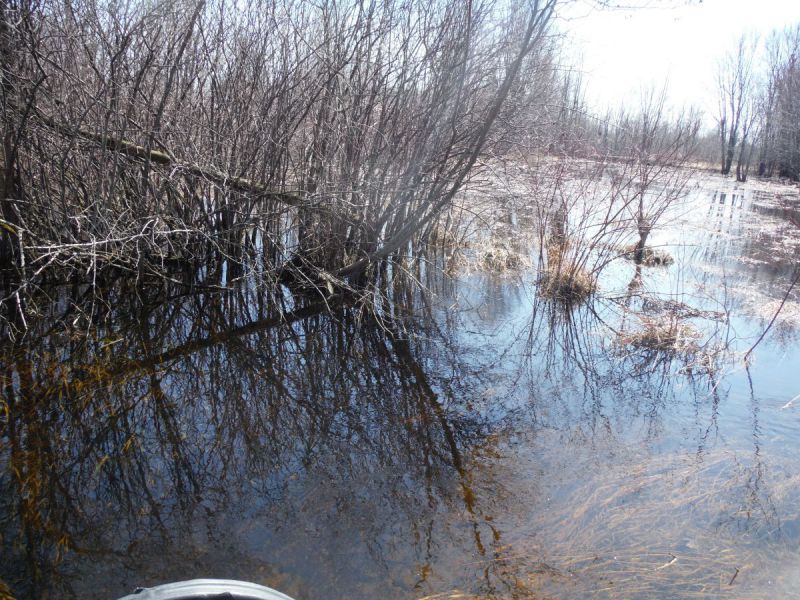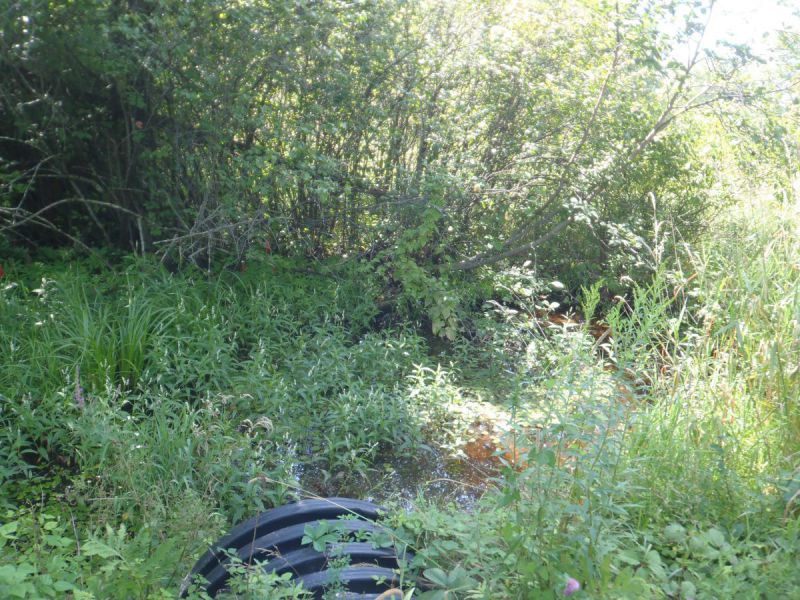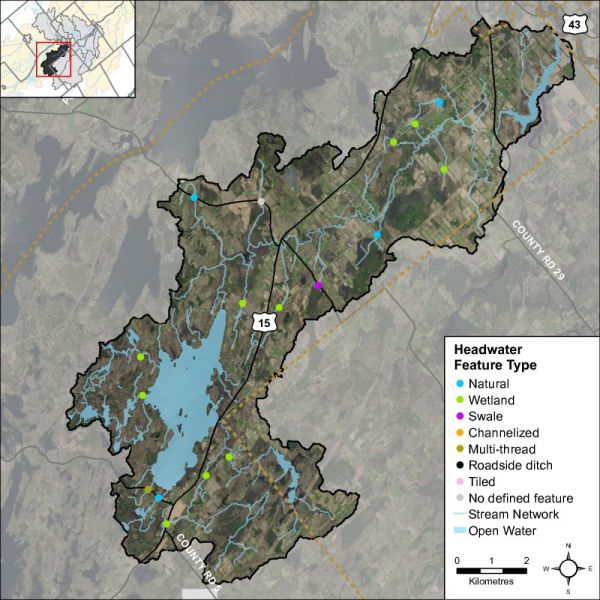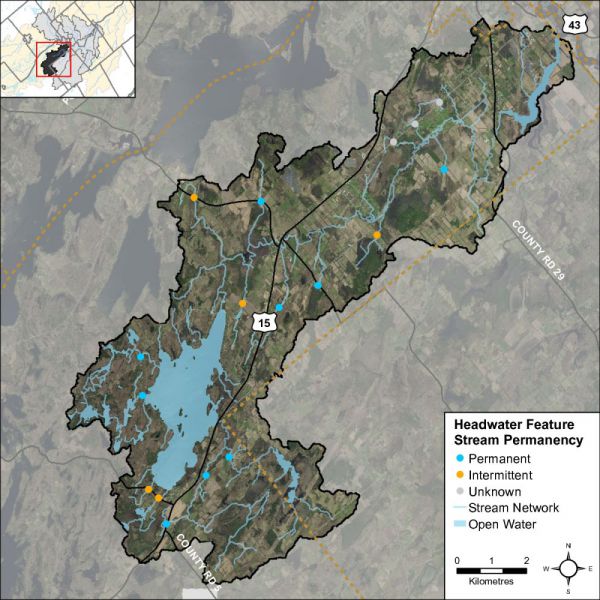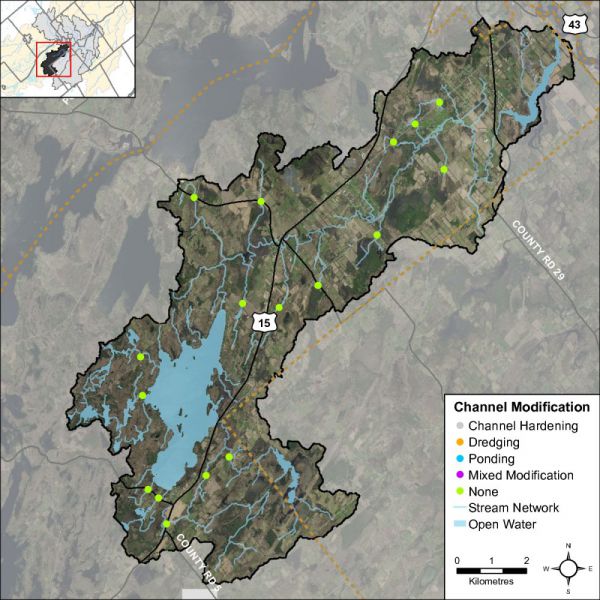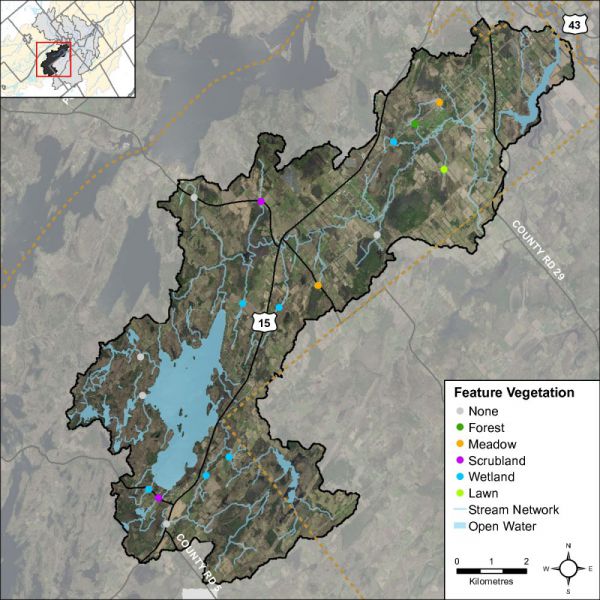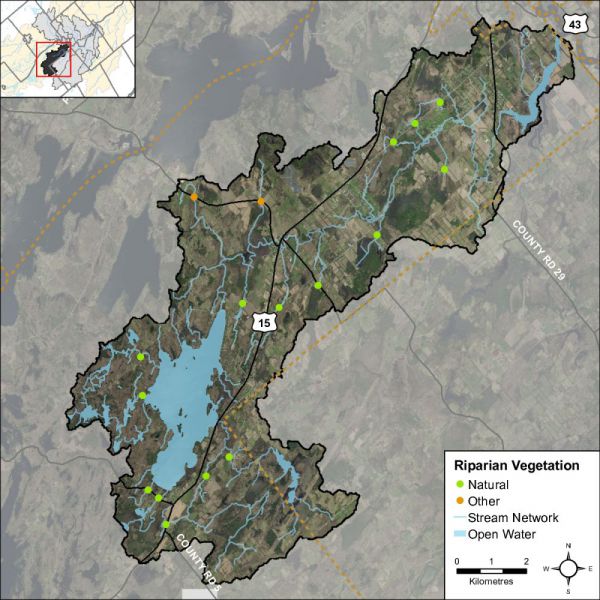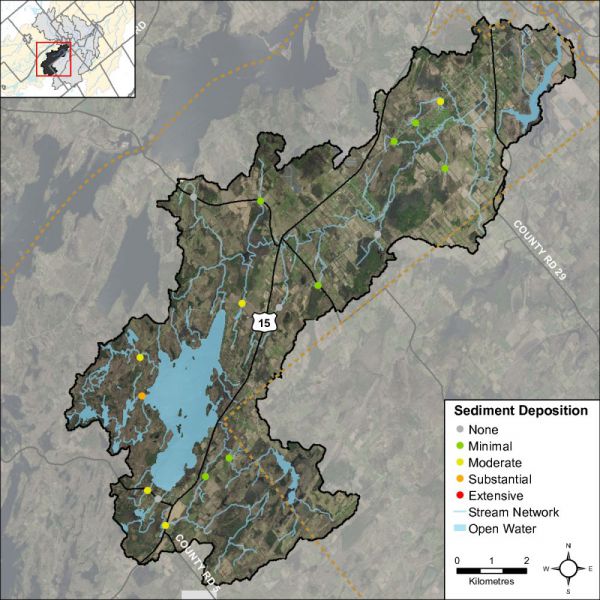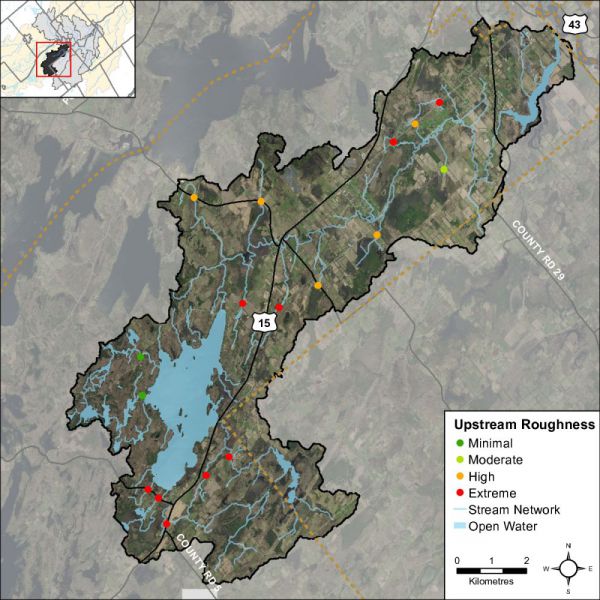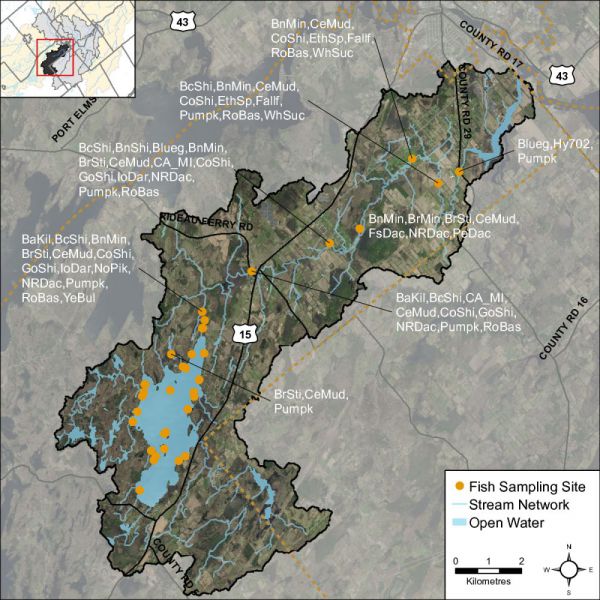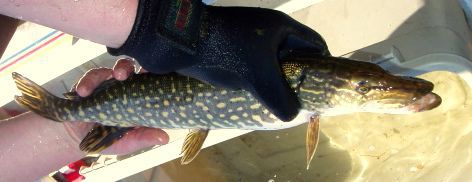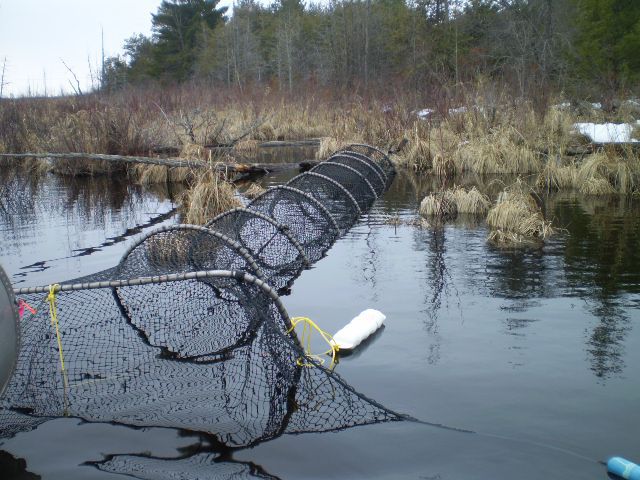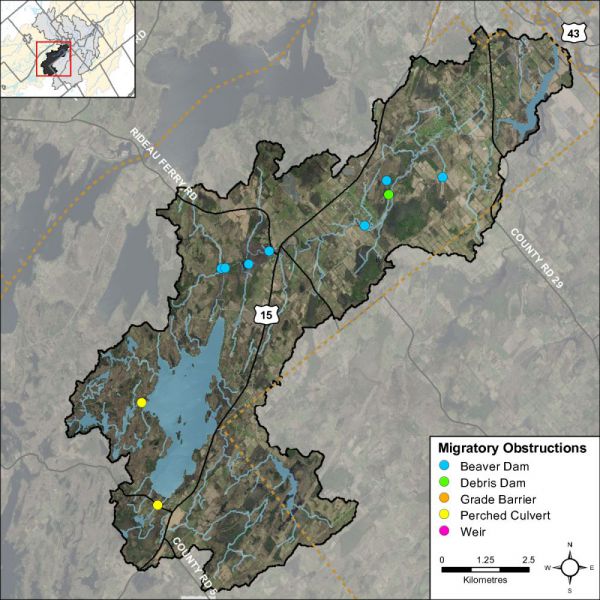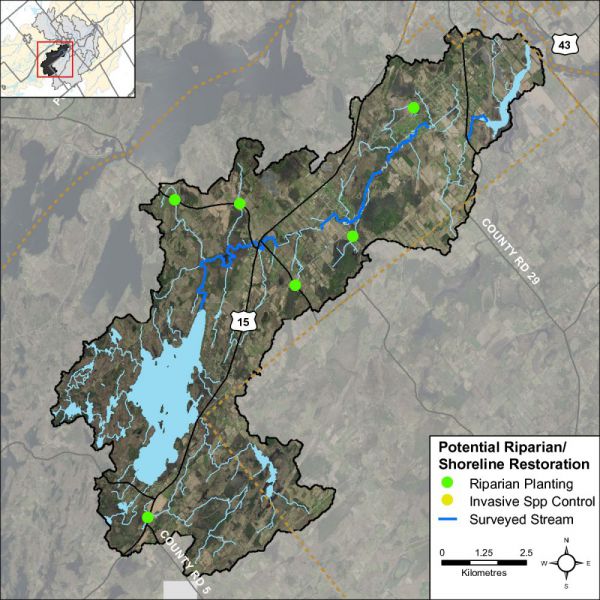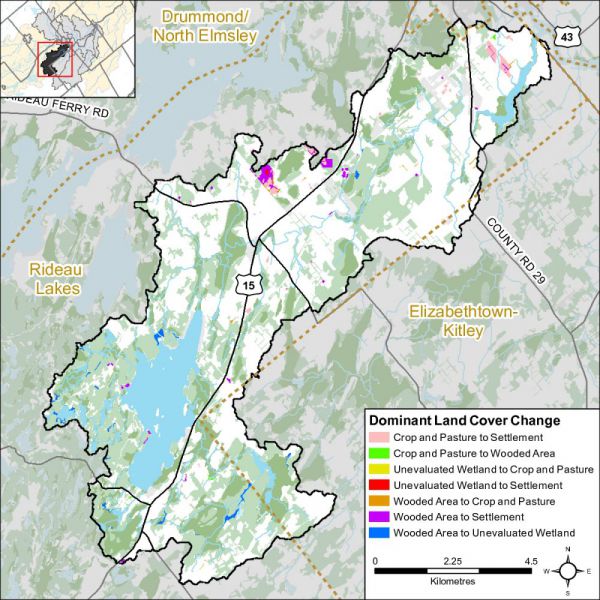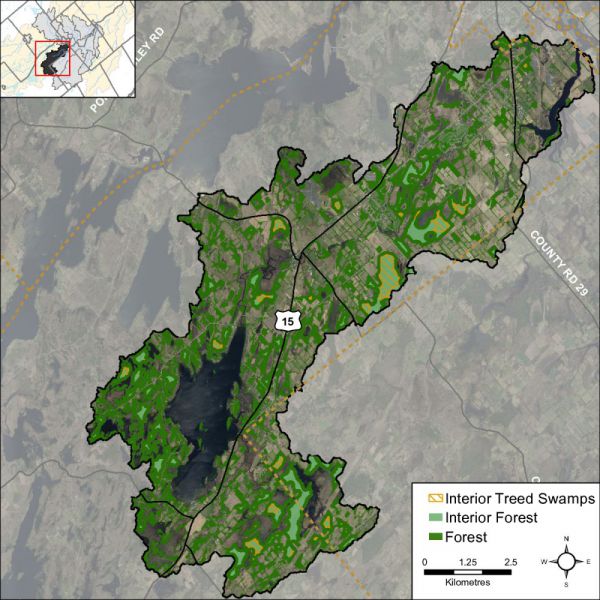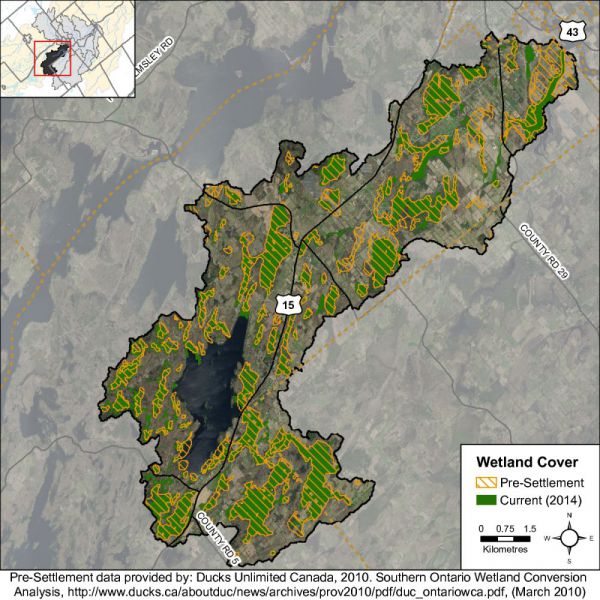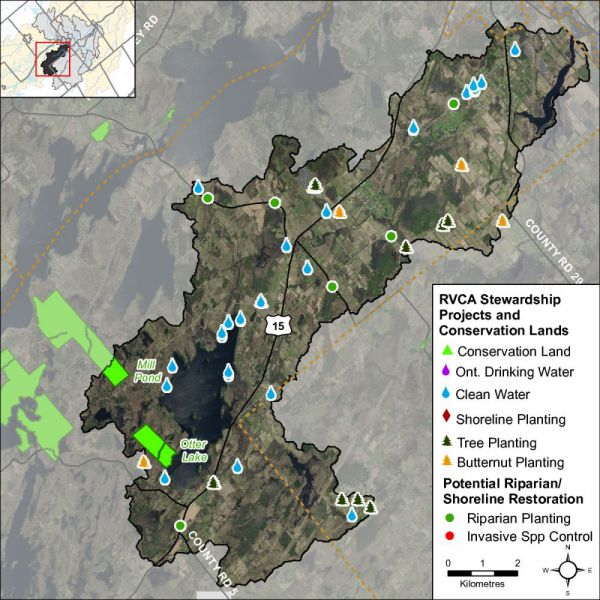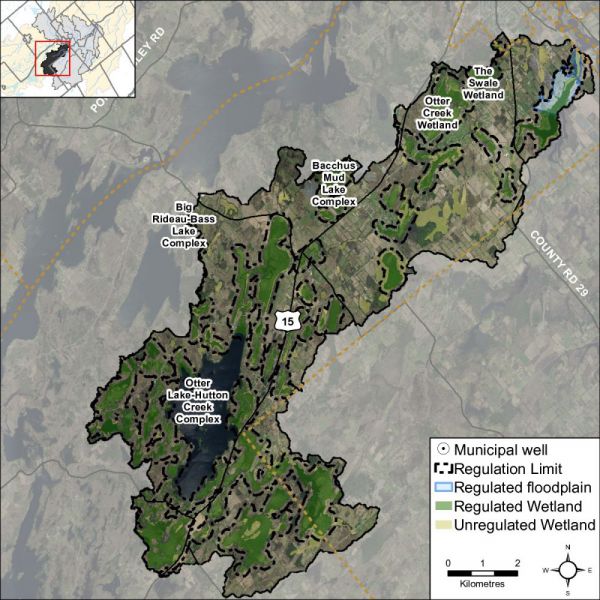Middle Rideau Subwatershed Report 2015
OTTER LAKE AND CREEK CATCHMENT
The Rideau Valley Conservation Authority produces individual reports for ten catchments in the Middle Rideau subwatershed. Using data collected and analysed by the RVCA through its watershed monitoring and land cover classification programs, surface water quality conditions are reported for Otter Lake and Otter Creek along with a summary of environmental conditions for the surrounding countryside every six years.
This information is used to better understand the effects of human activity on our water resources, allows us to better track environmental change over time and helps focus watershed management actions where they are needed the most to help sustain the ecosystem services (cultural, aesthetic and recreational values; provisioning of food, fuel and clean water; regulation of erosion/natural hazard protection and water purification; supporting nutrient/water cycling and habitat provision) provided by the catchment’s lands and forests and waters (Millennium Ecosystem Assessment 2005).
The following pages of this report are a compilation of that work and contain information on surface water quality, riparian conditions, land cover, stewardship activity and hazard land and water resources protection.
1. Catchment Facts
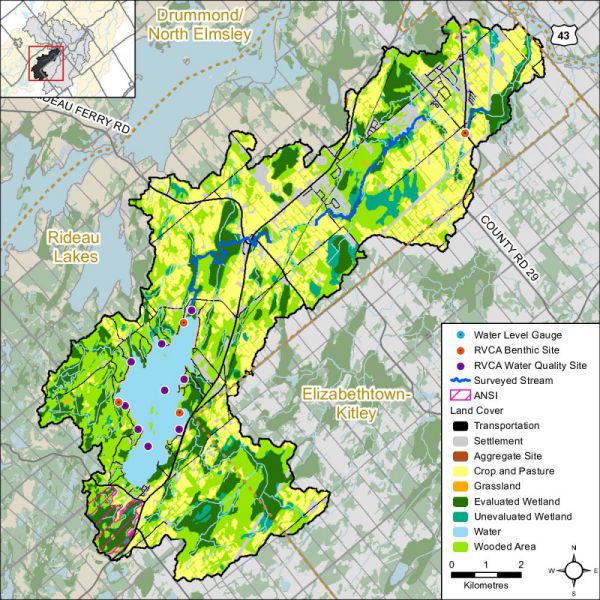
General Geography
- The Rideau River flows through the heart of the Middle Rideau and is a focal point for residents and visitors to the area. It extends from the outlet of Lower Rideau Lake at Poonamalie (where there is one dam and one lock) to Burritts Rapids (where there is also a dam and lock), at which point it enters the Lower Rideau on its way to Rideau Falls. The Rideau River is also an integral part of the Rideau Canal National Historic Site of Canada and is a significant tourist attraction which draws boaters, cottagers, and campers to the area
- Smiths Falls, Merrickville and Burritts Rapids are the main urban settlements in the Middle Rideau subwatershed. Otter Lake is a major rural area of settlement in the catchment and Lombardy is the main urban area. Other areas of the catchment are predominantly rural in character with agriculture being a major land use
- Parks Canada staff manage water levels for recreational purposes along the Rideau Canal/Waterway that runs through the catchment, ensuring 1.5 metres of draft during the navigation season. In this managed system, water levels on the Rideau Canal are manipulated by operation of numerous dams. In the Middle Rideau subwatershed, Parks Canada staff operate 9 dam and lock complexes with 13 locks for a fall of 36.2 metres over 35.6 kilometres. Water levels are maintained as close as possible to set objectives through the May to October navigation season. The levels are lowered through the rest of October and into November and held at the winter levels until the spring freshet in late March or early April naturally increases inflows to the system. To reduce the impact of the higher flows in the spring, the amount of snow water equivalent, forecast rain, ice cover, flows and levels are assessed and the dams in the Middle Rideau reach are operated accordingly to quickly pass as much water as possible. In late April and early May, the dams are gradually closed and water levels are brought up to be ready, once again, for the navigation season
Physical Geography
- The lower three-quarters of the Otter Creek Catchment and the rest of the Middle Rideau Subwatershed primarily resides within the Smith Falls Limestone Plain, which in this area, happens to consist of older Paleozoic quartz sandstone and dolostone of the March Formation. Small sections of the bedrock in the middle and lower catchment areas are overlain by sandy glacial till. Drumlins are found in these areas. The rest of the bedrock in the catchment is overlain by a thin veneer of glacial sediment, referred to as ‘drift’ that is generally less than a metre in thickness. Geologic faults are likely located in the lower one-quarter of the catchment
- The upper one-quarter of the catchment resides within the Algonquin Highlands, which is an ancient (Precambrian) hilly area made up of thin and variable glacial deposits overlying igneous and metamorphic rock ridges and knolls. In this area, rocks consist mainly of marble and rocks associated with ancient geologic faulting
- Ninety-three percent of the catchment lies within the Township of Rideau Lakes and seven percent within the Township of Elizabethtown-Kitley
- Otter Lake and Creek catchment drainage area is 89 square kilometres and occupies about 11 percent of the Middle Rideau subwatershed and two percent of the Rideau Valley watershed
Vulnerable Areas
- The Assessment Report developed under the Ontario Clean Water Act identifies the upper bedrock aquifer underlying all of the catchment area as a Highly Vulnerable Aquifer with parts of the Nepean Sandstone found at the surface near Otter Lake also considered a Significant Groundwater Recharge Area
- Certain lands around Otter Lake are subject to flooding hazard during the regional storm flood (the 100 year flood) conditions in the area. Surveys and studies undertaken in accordance with provincial standards have determined that the 100 year flood elevation for the lake is 125.5 metres above mean sea level
Development/Trends
- There are about 330 residential properties (cottages /homes) and four commercial properties on Otter Lake with no back lot development to-date. Otter Lake has an average shoreline density of 15 properties per kilometer. Much of the waterfront property around Otter Lake was developed from the 1930’s through to the 1960’s. As the supply of subdivided lots has dwindled, the rate of new construction on new lots has slowed and been subsequently overtaken by the conversion (redevelopment) of existing cottages to large permanent residences on small lots, which continues to the present. Any new lot development is typically confined to marginal lands (with steep slopes, shallow soils, narrow waterfronts, low lying poorly-drained soils) as the remaining lands have been fully developed. This can put additional stress on the lake environment because large development envelopes on smaller lots leave less space for natural processes (e.g., runoff, infiltration and retention, nutrient uptake, erosion control and shading) and natural features (e.g., trees, shrubs and plants) that support a healthy lake environment. Minor variances are frequently triggered because the lots do not have sufficient area to provide for a minimum 30 metre development setback from the lake
- Land use in the catchment is predominately Rural (RU) and Agricultural (A) with some areas of Rural Estate Lot Subdivision (RG) located to the south of Smiths Falls. The majority of properties along the shoreline of Otter Lake are zoned Waterfront Residential (RW). Access to Otter Lake is provided via a combination of public and privately maintained roads with the majority of waterfront properties serviced by private roads. The main settlement in the catchment is the village of Lombardy, which includes both residential and commercial uses
Conditions at a Glance
Water Quality
- Surface chemistry water quality rating in Otter Lake and Otter Creek is “Fair” over two reporting periods (2003-2008; 2009-2014)
- Previous surface chemistry water quality reporting for Otter Lake presented in the 2003 Otter Lake State of the Lake Environment report noted that Otter Lake had a moderate concentration of nutrients, generally suitable fish habitat conditions and good water clarity. The data presented in the Surface Water Quality Conditions section of this 2015 report indicates that Otter Lake continues to have these conditions
- Elevated bacterial counts and nutrient concentrations from inflows of nutrients (from private septic systems, agricultural, commercial, residential surface and stormwater runoff) are a feature of Otter Creek and although surface water quality conditions have improved between the two monitoring periods, decreased nutrient and bacterial counts are needed to improve the overall health of the creek
- Instream biological water quality conditions at the Otter Creek sample location range from “Very Poor” to “Fair” from 2003 to 2014 (using a grading scheme developed by Ontario Conservation Authorities in Ontario for benthic invertebrates) with an overall benthic invertebrate water quality rating of “Poor” determined for this period
Instream and Riparian
- Overall instream and riparian condition for the Otter creek catchment as assessed by the stream characterization and headwater drainage feature assessment programs show that Otter Creek and its tributaries are in good condition. The majority of the system has low erosion levels and a healthy riparian corridor with good instream diversity of aquatic habitat. There are opportunities to improve riparian habitat along several identified headwater drainage features
- The Otter Creek catchment has 25 species of recreational and bait fish and is classified as having a warm/cool water thermal guild that supports the Otter Creek fishery
- In the Otter Lake and Creek catchment (in 2014), the riparian buffer (30 m. wide strip along the shoreline of all lakes and streams) is comprised of wetland (56 percent), woodland (24 percent), crop and pastureland (10 percent), settlement areas (seven percent) and transportation routes (three percent)
- Along Otter Creek and tributaries (in 2014), the riparian buffer is comprised of woodland (60 percent), roads (17 percent), wetland (15 percent), crop and pastureland (six percent) and settlement areas (two percent)
- Around Otter Lake (in 2014), the shoreline is dominated by cottages, houses and recreational camps (50 percent) with the remainder composed of woodland (23 percent), wetland (22 percent) and roads (five percent)
- 1994 summer survey of 100 properties on Otter Lake completed by the Township of South Elmsley determined that approximately 42 percent of its shoreline was “natural” and approximately 45 percent was “manicured lawn”. It was further estimated that the lake had 34 percent of all lots in an “untouched” state (Otter Lake Sustainable Lake Report 2015)
Land Cover
- Dominant land cover is woodland (30 percent) and crop and pastureland (29 percent) followed by wetland (22 percent), water (six percent), settlement areas (nine percent) and roads (four percent). From 2008 to 2014, there was an overall change of 138 hectares (from one land cover class to another), most of which can be attributed to the conversion of crop and pastureland and woodland to settlement along with woodland to wetland encroachment
- Woodland cover in the catchment has decreased by 64 hectares between 2008 and 2014 and interior forest habitat has decreased by 27 hectares
- Wetland cover has decreased by three percent (261 ha) from pre-settlement times to the present and now occupies 22 percent of the catchment area
Other
- Approximately 860 in-use water wells with provincial records exist in this catchment. While most water wells are used for domestic water supply, several are also used for commercial, agricultural, and public water supplies
- There are no active Permits to Take Water or Environmental Compliance Approvals in the catchment; nor are there any open or closed aggregate operations in the catchment
Catchment Care
- RVCA has monitored surface water quality in the Otter Lake and Creek catchment through its Watershed Watch Program since 2002. In 2006, the program was altered to gain consistent, year to year data for the set of lakes being monitored. RVCA monitors surface water quality in Otter Lake four times of the year at two deep point sites (eight samples annually), twice a year at three shoreline sites (six samples annually) and twice a year at an additional four sites every fifth year (eight samples in total)
- RVCA has been collecting benthic invertebrates in Otter Creek at the County Road 29 site since 2003
- RVCA conducted a fish survey along Otter Creek in 2014
- RVCA completed a stream characterization survey on Otter Creek in 2014, working upstream to the headwaters from the mouth of the creek where it empties into the Rideau River taking measurements and recording observations on instream habitat, bank stability, other attributes and preparing a temperature profile
- RVCA completed 17 headwater drainage feature assessments at road crossings in the Otter Creek catchment in 2014. This protocol measures zero and first order headwater drainage features and is a rapid assessment method characterizing the amount of water, sediment transport, and storage capacity within headwater drainage features
- RVCA provides septic system re-inspection at the request of the Township of Rideau Lakes. From 2007 to 2015, the Mississippi Rideau Septic System Office performed 66 voluntary septic system re-inspections on Otter Lake properties. Remedial/maintenance work was recommended for 62 percent of those properties that were inspected, septic system replacements at another two properties with more information provided to two other landowners with identified septic system concerns. No specific concerns were noted for the other 21 septic systems that were inspected
- Thirty-six stewardship projects have been completed with assistance from the RVCA’s Rural Clean Water and Tree Planting Programs (see Section 5 of this report for details)
- The Otter Lake Landowners’ Association is an association of property owners from all around Otter Lake that was formed in 1992. OLLA's objectives are simple and straightforward - to maintain the health of Otter Lake by working with local and regional governments, existing road associations, and individual landowners with properties on Otter Lake. The vision for the lake, as documented in the Otter Lake Sustainable Lake Plan is “A place where water quality, fish and wildlife habitat, natural beauty, recreational opportunities and peace and tranquility is maintained and improved for present and future generations to enjoy.” Values identified by property owners (in a 2015 survey) as very important include water quality (94%), swimming (70%), peace and quiet (60%), wildlife and bird watching (40%), natural shorelines (39%), sailing and paddling (39%), fishing (16%) and boating (13%). Some of the Association’s water resources management and aquatic/terrestrial habitat protection efforts include:
- Ongoing water quality monitoring of E. coli, Nitrogen and Phosphorous in conjunction with the RVCA and reporting of water quality results back to the community
- Continuing promotion of the voluntary septic system re-inspection program that the Township of Rideau Lakes introduced in 2007
- Promoting existing stewardship programs (like the RVCA’s Shoreline Naturalization Program) to the lake community to protect and enhance shorelines and protect water quality
- Continuing the water level monitoring program on Otter Lake Continue and reporting findings of the monitoring program to the community on a regular basis
- Visit Otter Lake Landowners’ Association to learn more about its activities and to view the Otter Lake Sustainable Lake Plan
- A watershed model developed by the RVCA in 2009 was used to study the hydrologic function of wetlands in the Rideau Valley Watershed, including those found in the Otter Lake and Creek catchment
- Several MOE Permits to Take Water have been issued in the vicinity of Otter Creek for golf course irrigation and water supply; for groundwater supply wells in Otterdale Estates and for a wetland conservation project requiring surface water impoundment
- Several other MOE Environmental Compliance Approvals have been issued for the disposal of effluent from large septic treatment systems at a campground, a children’s camp and a mobile home park
- The Township of Rideau Lakes has land use planning policies and zoning provisions - on lake capacity, water setbacks, frontage and naturalized shorelines and wetland protection - and use site plan control to implement these policies and provisions. Together with RVCA, the Township works with landowners on a case by case basis to achieve net environmental gains (particularly with respect to shoreline vegetation protection and rehabilitation) through the application of shoreline best management practices. Through the land-use planning process, the Township, RVCA and agencies request conditions of approval to ensure that development and redevelopment is appropriate for the property, impacts on neighbours are minimized (particularly on very small lots) and development setbacks for the shoreline are maximized
- Development in and adjacent to Provincially Significant Wetlands and some locally significant wetlands is subject to Ontario Regulation 174-06 (entitled “Development, Interference with Wetlands and Alterations to Shorelines and Watercourses”) that protects the hydrologic function of the wetland and also protects landowners and their property from natural hazards (flooding, fluctuating water table, unstable soils) associated with them
- The shoreline of Otter Lake is held in private ownership, so that the best opportunity for shoreline restoration/enhancement rests with private landowners. RVCA offers its Shoreline Naturalization Program to Otter Lake landowners to assist with shoreline re-vegetation
2. Surface Water Quality Conditions
Surface water quality conditions in the Otter Lake and Creek catchment are monitored by the Rideau Valley Conservation Authority’s (RVCA) Watershed Watch Program and Baseline Water Quality Monitoring Program. Watershed Watch monitors watershed lakes to assess nutrient concentrations, water clarity, dissolved oxygen availability and pH. The baseline water quality program focuses on streams; data is collected for 22 parameters including nutrients (total phosphorus, total Kjeldahl nitrogen and ammonia), E. coli, metals (like aluminum and copper) and additional chemical/physical parameters (such as alkalinity, chlorides, pH and total suspended solids). Figure 1 shows the locations of monitoring sites in the catchment.
Figure 1 Water quality monitoring sites on Otter Lake and Creek
Otter Lake and Creek Water Quality
Water Quality Rating
The water quality rating for Otter Lake and Otter Creek (OTT-01) is “Fair” (Table 1) as determined by the Canadian Council of Ministers of the Environment (CCME) Water Quality Index. A "Fair" rating indicates that water quality is usually protected but is occasionally threatened or impaired; conditions sometimes depart from natural or desirable levels. Each parameter is evaluated against established guidelines to determine water quality conditions. Those parameters that frequently exceed guidelines are presented below. Analysis of the data has been broken into two periods; 2003 to 2008 and 2009 to 2014 to examine if conditions have changed between these periods. Table 1 shows the overall rating for the monitored surface water quality sites within the Otter Creek catchment and Table 2 outlines the Water Quality Index (WQI) scores and their corresponding ratings. It should be noted that Otter Lake WQI stayed within the Fair rating range, however the score dropped from 77 to 65, which is the lowest rating in that category before moving to a poor rating.
Table 1 Water Quality Index ratings for the Otter Creek Catchment
Table 2 Water Quality Index ratings and corresponding index scores (RVCA terminology, original WQI category names in brackets)
2) a. Otter Lake Water Quality
Surface water quality conditions in Otter Lake (RVL-26) have been monitored by RVCA’s Watershed Watch Program since 2003. Data from two deep point sites have been used to calculate the WQI rating for Otter Lake, which was determined to be “Fair” (Table 1). Moderate nutrient concentrations, good oxygen availability, clear water and occasionally elevated pH levels contributed to the rating. The following discussion explains how each of the monitored water quality parameters contributes to the lake’s water quality.
This report also considers data from seven additional shoreline sites that are monitored around the lake. These sites have not been included in the calculation of the CCME WQI rating, as they are not monitored with the same frequency as deep point sites. However, they do provide important information on water quality conditions in the near shore areas. For locations of shoreline sites please see Figure 1.
The 2003 Otter Lake State of the Lake Environment Report (Rideau Valley Conservation Authority, 2005) noted that Otter Lake had a moderate concentration of nutrients, generally suitable fish habitat conditions and good water clarity. The data presented in this report indicates that this continues to be the case and that a proactive cautionary program of best management practices is important to ensure the protection of the lake environment.
Nutrients
Total phosphorus (TP) is used as a primary indicator of excessive nutrient loading and contributes to abundant aquatic vegetation growth and depleted dissolved oxygen levels. The Provincial Water Quality Objective (PWQO) is used as the TP Guideline and states that in lakes, concentrations greater than 0.020 mg/l indicate an excessive amount of TP within the water column.
Total Kjeldahl nitrogen (TKN) is used as a secondary indicator of nutrient loading. RVCA uses a guideline of 0.500 mg/l to assess TKN[1] within surface waters.
At the Deep Points
TP and TKN sampling results are presented in Figures 2 to 5. In the 2003 to 2008 period, 100 percent of samples analyzed for TP were less than the TP guideline and stayed fairly consistent at 97 percent in the 2009 to 2014 period. The average TP concentration slightly increased from 0.009 mg/l to 0.010 mg/l. TKN concentrations were fairly normal with 97 percent of reported results below the TKN guideline in the first period (2003-2008); this decreased to 89 percent of samples in the 2009 to 2014 period. The average TKN concentration declined from 0.411 mg/l to 0.404 mg/l (Table 3).
Figure 2 Total phosphorous sampling results at deep point sites on Otter Lake, 2003-2008
Figure 3 Total phosphorous sampling results at deep point sites on Otter Lake, 2009-2014
Figure 4 Total Kjeldahl nitrogen sampling results at deep point sites on Otter Lake, 2003-2008
Figure 5 Total Kjeldahl nitrogen sampling results at deep point sites on Otter Lake, 2009-2014
Table 3 Summary of nutrient results for Otter Lake over two monitoring periods (2003-2008 and 2009-2014)
Average year to year concentrations have varied for both TP and TKN (Figures 6-9) from 2003-2008 and 2009-2014. An increase in average concentrations from 2008 to 2013 is visible, however all average TP and TKN results are below the guidelines in both monitoring periods (2003-2008 and 2009-2014). Overall, the data presented indicates that nutrient concentrations may be considered moderate in the mid-lake, deep water sites on Otter Lake.
Figure 6 Average total phosphorous results at deep point sites on Otter Lake, 2003-2008
Figure 7 Average total phosphorous results at deep point sites on Otter Lake, 2009-2014
Figure 8 Average total Kjeldahl nitrogen results at deep point sites on Otter Lake, 2003-2008
Figure 9 Average total kjeldahl nitrogen results at deep point sites on Otter Lake, 2009-2014
Around the Lake
The average nutrient concentrations at monitored shoreline sites around the lake vary from year to year (Figures 10-13). Please note that in the 2003-2008 monitoring period, sites were not sampled in 2004 and 2005. Sites B, C and F were sampled in 2003, 2006, 2007 and 2008 while sites A, D, E and G were only sampled in 2003 and 2008. In the second monitoring period (2009-2014) sites B, C and F were sampled every year, while sites A, D, E and G were sampled every fifth year.
Average total phosphorous concentrations are below the TP guideline at all sites in both monitoring periods (Figures 10 and 11), indicating nutrient enrichment does not to appear to be a problem in the monitored near shore areas.
TKN concentrations were also below the guideline at monitored sites; with the exception in 2013 at sites C and F which showed TKN concentrations above the guideline. Nutrient enrichment does not appear to be a problem in the monitored shoreline sites on Otter Lake (Figures 12 and 13).
Figure 10 Average total phosphorous concentrations at shoreline monitoring sites in Otter Lake, 2003-2008
Figure 11 Average total phosphorous concentrations at shoreline monitoring sites in Otter Lake, 2009-2014
Figure 12 Average total Kjeldahl nitrogen concentrations at shoreline monitoring sites in Otter Lake, 2003-2008
Figure 13 Average total Kjeldahl nitrogen concentrations at shoreline monitoring sites in Otter Lake, 2009-2014
Summary
Otter Lake nutrient concentrations are generally below the guidelines, with few exceedances. Average TP and TKN results (Table 3) are comparable to the 2003 Otter Lake State of the Lake Environment Report (Rideau Valley Conservation Authority, 2005) with TP concentrations of about .010 mg/l and TKN concentrations of about .445 mg/l.
Efforts such as the diversion of runoff and enhanced shoreline buffers are important to continue to protect and enhance water quality and reduce future nutrient exceedances. Nutrient exceedances may be partially attributed to the natural aging of a lake and basin characteristics. All residents can help reduce their impact on the lake by reducing nutrient inputs through practices such as proper maintenance of septic systems, keeping shorelines natural and using phosphate free soaps and detergents.
Water Clarity
Water clarity is measured using a Secchi disk during each deep point sample. Table 4 summarizes the recorded depths and shows that all readings have exceeded the minimum PWQO of 2 metres indicating that algae in the water column is not at excessive levels (good water clarity). Less than 2 m will indicate overproduction in a lake. The average Secchi depth increased from 5.8 metres (2003- 2008) to 6.4 metres (2009-2014). Figures 14 and 15 show that no individual reading has been below the guideline and measured depths range from 3.5 metres (Figure 15) to 12.5 metres (Figure 15). It should be noted that Secchi depths in many waterbodies have been influenced by the colonization of zebra mussels resulting in clearer waters than may have been seen prior to the introduction of this species; zebra mussels have been reported in Otter Lake since 2001.
Table 4 Summary of Secchi depths recorded at the deep point sites on Otter Lake, 2003-2008 and 2009-2014
Figure 14 Recorded Secchi depths at the deep point sites on Otter Lake, 2003-2008
Figure 15 Recorded Secchi depths at the deep point sites on Otter Lake, 2009-2014
Summary
Waters on Otter Lake are very clear and sufficient sunlight is able to penetrate the water column to support aquatic life and provide sufficient visibility for safe recreational use (boating, swimming). The 2003 Otter Lake State of the Lake Environment Report (Rideau Valley Conservation Authority, 2005) reported Secchi depths between 2.7 and 5.6 metres. The increase in water clarity can likely be attributed to the establishment of zebra mussels found in Otter Lake.
Fish Habitat
Two other factors, dissolved oxygen/temperature and pH were also assessed to provide an overall sense of the health of Otter Lake from a fish habitat perspective.
Dissolved Oxygen and Temperature
The red bars in Figures 16-19 show the depths where suitable conditions exist for cool water fish species (temperature less than 25°C and dissolved oxygen greater than 4 mg/l) at the monitored deep point sites (RVL-26DP1 and RVL-26DP3). The vertical axis represents the total lake depth at each site where the profile is taken. Suitable habitat conditions increased over the two time periods from an average of 21.5 metres at RVL-26DP1 (Figure 16) in 2003-2008 period to 24.1 metres (Figure 18) in the 2009-2014 period. Deep point site RVL-26DP3 increased from and 21.9 metres (Figure 17) in 2003-2008 period to 24.9 metres (Figure 19) in the 2009-2014 monitoring period.
Figure 16 Depths suitable for warm water fish species at site RVL-26DP1, 2003-2008
Figure 17 Depths suitable for warm water fish species at site RVL-26DP3, 2003-2008
Figure 18 Depths suitable for cool water fish species at site RVL-26DP1, 2009-2014
Figure 19 Depths suitable for cool water fish species at site RVL-26 DP3 2009-2014
pH
pH is a basic water quality parameter used to assess the acidity of water, an important factor for aquatic life. Figures 20 and 21 show pH concentrations in Otter Lake while Figures 22 and 23 summarize average concentrations by year.
Figure 20 pH concentrations at the deep point sites on Otter Lake, 2003-2008
Figure 21 pH concentrations at the deep point sites on Otter Lake, 2009-2014
Figure 22 Average pH concentrations at the deep point sites on Otter Lake, 2003-2008
Figure 23 Average pH concentrations at the deep point sites on Otter Lake, 2009-2014
The majority of samples for both time periods were within guidelines established by the PWQO which state that pH should be between 6.5 and 8.5 to protect aquatic life and prevent irritation for anyone using the waters for recreational purposes (Table 5). Average results border on the upper limit of the guideline and there was very little change between both monitoring periods indicating that elevated pH is a feature of this lake. Surface water’s that are found to be more alkaline (higher pH) can generally be attributed to the geology rather than anthropogenic activities. Biological activities such as photosynthesis may also affect pH.
Table 5 Summary of pH results at the deep point sites on Otter Lake, 2003-2008 and 2009-2014
Summary
Overall the water chemistry data at the deep point describes suitable habitat conditions for warm water fish species such as yellow perch, walleye and pike. There is some evidence that the warming of the water column in the late summer/fall may limit the amount of habitat for some sensitive species. pH conditions are typically on the upper end of the range recommended for the protection of aquatic life. Overall, the data indicates a healthy environment for aquatic species.
E. Coli
E. coli is sampled at monitored shoreline sites twice each sampling season. E. coli data was not used in the calculations of the WQI rating for the lake due to differences in sampling frequency and site locations. In both monitoring periods (2003-2008 and 2009-2014) all samples were below the E. coli guideline of 100 colony forming units (CFU) per 100 ml set by the PWQO. Across the lake for both monitoring periods the count at the geometric mean[2] was only 2 CFU/100ml (Table 6).
Table 6 Summary of E. coli results for Otter Lake, 2003-2008 and 2009-2014
Figure 24 Geometric mean of shoreline sites monitored on Otter Lake, 2003-2008
Figure 25 Geometric mean of shoreline sites monitored on Otter Lake, 2009-2014
Figures 24 and 25 show the distribution of counts across all shoreline sites. All sites fall well below the guideline of 100 CFU/100ml. This is consistent with E. coli results from the 2003 Otter Lake State of the Lake Environment Report (Rideau Valley Conservation Authority, 2005) that indicated an average of 2.5 CFU/100ml.
Summary
The results presented above provide evidence that bacterial contamination is not a significant concern in Otter Lake and the water should be safe for recreational use such as swimming and boating.
2) b. Otter Creek Water Quality
There is one stream site on Otter Creek monitored in the Otter Lake and Creek catchment (OTT-01, Figure 1). Analysis of the data has been broken into two periods, 2003-2008 and 2009-2014, to examine if conditions have changed within this timeframe. Water quality at this site is reported as “Fair” (Table 1). The score at this site is largely influenced by elevated nutrient concentrations, metals and high bacterial counts. For more information on the CCME WQI, please see the Middle Rideau Subwatershed Report 2015.
Nutrients
Total phosphorus (TP) is used as a primary indicator of excessive nutrient loading and may contribute to abundant aquatic vegetation growth and depleted dissolved oxygen levels. The Provincial Water Quality Objective (PWQO) is used as the TP Guideline and states that in streams concentrations greater than 0.030 mg/l indicate an excessive amount of TP.
Total Kjeldahl nitrogen (TKN) and ammonia (NH3) are used as secondary indicators of nutrient loadings. RVCA uses a guideline of 0.500 mg/l to assess TKN[1] and the PWQO of 0.020 mg/l to assess ammonia concentrations at the monitored site.
Tables 7, 8 and 9 summarize average nutrient concentrations at monitored sites within the Otter Lake and Creek catchment and show the proportion of results that meet the guidelines.
Table 7 Summary of total phosphorous results for Otter Creek, 2003-2008 and 2009-2014. Highlighted values indicate average concentrations that exceed the guideline
Table 8 Summary of total Kjeldahl nitrogen results for Otter Creek, 2003-2008 and 2009-2014. Highlighted values indicate average concentrations that exceed the guideline
Table 9 Summary of Ammonia results for Otter Creek, 2003-2008 and 2009-2014. Highlighted values indicate average concentrations that exceed the guideline
Elevated TP results were a regular occurrence in the 2003-2008 monitoring period at site OTT-01. The 2009-2014 monitoring period saw an improvement with less exceedances. Site OTT-01 had 29 percent of samples that were below the guideline in the 2003-2008 period (Figure 26); this increased to 59 percent of samples in the 2009-2014 period (Figure 27). The average TP concentration also decreased from 0.041 mg/l to 0.030 mg/l (Table 7).
Figure 26 Total phosphorous concentrations in Otter Creek, 2003-2008
Figure 27 Total phosphorous concentrations in Otter Creek, 2009-2014
TKN results show that the bulk of results exceeded the guideline (Figures 28 and 29); there were few samples (17 percent) below the guideline in the 2003-2008 period and this declined to only 16 percent in the 2009-2014 period. The average concentration was generally elevated and decreased from 0.712 mg/l to 0.672 mg/l (Table 8).
Figure 28 Total Kjeldahl nitrogen concentrations in Otter Creek, 2003-2008
Figure 29 Total Kjeldahl nitrogen concentrations in Otter Creek, 2009-2014
The trend of elevated nutrients is also observed in NH3 data, as results at this site were generally above the guideline of 0.020 mg/l (Figures 30 and 31); the proportion of samples below the guideline remained the same with 58 percent. However, as observed with TP and TKN, this was accompanied by a decrease in the average concentration from 0.058 mg/l (2003-2008) to 0.016 mg/l (2009-2014).
Figure 30 Ammonia concentrations in Otter Creek, 2003-2008
Figure 31 Ammonia concentrations in Otter Creek, 2009-2014
Summary
The data shows that nutrient enrichment is a feature of Otter Creek. High nutrient concentrations can help stimulate the growth of algae blooms and other aquatic vegetation in a waterbody and deplete oxygen levels as the vegetation dies off. It is important to reduce human impacts wherever possible. Strategies to reduce nutrient inputs may include diversion of runoff to the creek and enhanced shoreline buffers.
E. Coli
E. coli is used as an indicator of bacterial pollution from human or animal waste; in elevated concentrations it can pose a risk to human health. The PWQO of 100 colony forming units/100 milliliters (CFU/100 ml) is used to assess E. coli. Counts greater than this guideline indicate that bacterial contamination may be a problem within a waterbody.
Table 10 summarizes the geometric mean[2] for the monitored site on Otter Creek and shows the proportion of samples that meet the E. coli guideline of 100 CFU/100 ml. The geometric mean with respect to the guideline for the two periods (2003-2008 and 2009-2014) is shown in Figures 32 and 33 respectively.
Table 10 Summary of E. coli results for Otter Creek, 2003-2008 and 2009-2014. Highlighted values indicated average concentrations have exceeded the guideline
E. coli results at site OTT-01 indicate bacterial counts are frequently above the E. coli guideline. The proportion of samples below the guideline improved from 21 percent (Figure 32) to 46 percent (Figure 33). Reduced counts are also observed at the geometric mean which declined from 313 CFU/100ml to 115 CFU/100ml (Table 10).
Figure 32 Geometric mean of E. coli results on Otter Creek, 2003-2008
Figure 33 Geometric mean of E. coli results on Otter Creek, 2009-2014
Summary
Results indicate that bacterial contamination is a concern in Otter Creek. There has been an improvement from the 2003-2008 monitoring period to the 2009-2014 monitoring period, however a majority of samples still exceed the PWQO. The count at the geometric mean is above the PWQO for both monitoring periods. Properly maintaining septic systems, enhancing shoreline buffers and restricting cattle access can help to improve E.coli levels in Otter Creek.
Metals
Of the metals routinely monitored in Otter Creek, aluminum (Al) and iron (Fe) occasionally reported concentrations above their respective PWQOs. In elevated concentrations, these metals can have toxic effects on sensitive aquatic species. Tables 11 and 12 summarize metal concentrations at the monitored site and show the proportion of samples that meet guidelines. Figures 34 to 36 show metal concentrations with respect to the guidelines for the two periods of interest, 2003–2008 and 2009–2014. For Al, the PWQO is 0.075 mg/l and for Fe it is 0.300 mg/l.
Results from OTT-01 shows that Al concentrations had some exceedances with 67 percent of samples below the guideline in the 2003-2008 period (Figure 34). This improved to 92 percent of samples in the 2009-2014 period (Figure 35). The average concentration of Al was 0.132 mg/l from 2003-2008 which exceeds the guideline. From 2009-2014 the average concentration improved to 0.025 mg/l which is below the guideline.
Table 11 Summary of Aluminum results for Otter Creek, 2003-2008 and 2009-2014
Table 12 Summary of Iron results for Otter Creek, 2003-2008 and 2009-2014
Figure 34 Average aluminum concentrations in Otter Creek, 2003-2008
Figure 35 Average aluminum concentrations in Otter Creek, 2009-2014
Iron concentrations also exceeded the guideline. The proportion of samples below the guideline increased from 74 percent to 92 percent (Figures 36 and 37). Although there were observed exceedances, the average concentration did not exceed the guideline in both monitoring periods; 0.241 mg/l in 2003-2008 and .068 mg/l in 2009-2014.
Figure 36 Average iron concentrations in Otter Creek, 2003-2008
Figure 37 Average iron concentrations in Otter Creek, 2009-2014
Summary
Overall, a general decline in metal concentrations was observed between the two periods of interest. Efforts should continue to be made to identify pollution sources and implement best management practices to reduce any inputs such as runoff, metal alloys, fungicides and pesticides to improve overall stream health and lessen downstream impacts.
[1] No Ontario guideline for TKN is presently available; however, waters not influenced by excessive organic inputs typically range from 0.100 to 0.500 mg/l, Environment Canada (1979) Water Quality Sourcebook, A Guide to Water Quality Parameters, Inland Waters Directorate, Water Quality Branch, Ottawa, Canada
[2] A type of mean or average, which indicates the central tendency or typical value of a set of numbers by using the product of their values (as opposed to the arithmetic mean which uses their sum). It is often used to summarize a variable that varies over several orders of magnitude, such as E. coli counts.
3. Otter Creek and Lake Riparian Conditions
Shoreline Buffer Land Cover Evaluation
The riparian or shoreline zone is that special area where land meets water. Well-vegetated shorelines are critically important in protecting water quality and creating healthy aquatic habitats, lakes and rivers. Natural shorelines intercept sediments and contaminants that could impact water quality conditions and harm fish habitat in streams. Well established buffers protect the banks against erosion, improve habitat for fish by shading and cooling the water and provide protection for birds and other wildlife that feed and rear young near water. A recommended target (from Environment Canada’s Guideline: How Much Habitat is Enough?) is to maintain a minimum 30 metre wide vegetated buffer along at least 75 percent of the length of both sides of rivers, creeks and streams.
Figure 38 shows the extent of the naturally vegetated riparian zone along a 30 metre wide strip of the shoreline of Otter Lake, Otter Creek and its tributaries. This information is derived from a dataset developed by the RVCA’s Land Cover Classification Program through heads-up digitization of 20cm DRAPE ortho-imagery at a 1:4000 scale, which details the catchment landscape using 10 land cover classes.
Figure 38 Natural and other riparian land cover in the Otter Lake and Creek catchment
This analysis shows that the Otter Lake and Creek catchment riparian buffer is comprised of wetland (56 percent), woodland (24 percent), crop and pastureland (10 percent), settlement areas (seven percent) and transportation routes (three percent). Along Otter Creek and its tributaries, the riparian buffer is comprised of woodland (60 percent), roads (17 percent), wetland (15 percent), crop and pastureland (six percent) and settlement areas (two percent). Around Otter Lake itself, the shoreline buffer is dominated by cottages, houses and recreational camps (50 percent) with the remainder composed of woodland (23 percent), wetland (22 percent) and roads (five percent).
Additional statistics for the Otter Lake and Creek catchment and Otter Lake itself are presented in Tables 13 and 14. Of particular interest is the observed increase in the area of “Settlement” along the shoreline of Otter Lake over a six year period.
Table 13 Riparian land cover (2008 vs. 2014) in the Otter Lake and Creek catchment
Table 14 Riparian land cover (2008 vs. 2014) around Otter Lake
Otter Creek Overbank Zone
Riparian Buffer Width Evaluation
Figure 39 demonstrates the buffer conditions of the left and right banks separately. Otter Creek had a buffer of greater than 30 meters along 86 percent of the right bank and 91 percent of the left bank.
Figure 39 Riparian buffer evaluation along Otter Creek
Adjacent Land Use
The RVCA’s Stream Characterization Program identifies seven different land uses beside Otter Creek (Figure 40). Surrounding land use is considered from the beginning to end of the survey section (100 m) and up to 100m on each side of the creek. Land use outside of this area is not considered for the surveys but is nonetheless part of the subwatershed and will influence the creek. Natural areas made up 91 percent of the stream, characterized by wetlands, forest, scrubland and meadow. The remaining land use consisted of infrastructure in the form of residential, recreational and road crossings.
Figure 40 Land Use along Otter Creek
Otter Creek Shoreline Zone
Instream Erosion
Erosion is a normal, important stream process and may not affect actual bank stability; however, excessive erosion and deposition of sediment within a stream can have a detrimental effect on important fish and wildlife habitat. Poor bank stability can greatly contribute to the amount of sediment carried in a waterbody as well as loss of bank vegetation due to bank failure, resulting in trees falling into the stream and the potential to impact instream migration. Figure 41 shows low levels of erosion along Otter Creek.
Figure 41 Erosion along Otter Creek
Undercut Stream Banks
Undercut banks are a normal and natural part of stream function and can provide excellent refuge areas for fish. Figure 42 shows that Otter Creek had low levels of undercut banks.
Figure 42 Undercut stream banks along Otter Creek
Stream Shading
Grasses, shrubs and trees all contribute towards shading a stream. Shade is important in moderating stream temperature, contributing to food supply and helping with nutrient reduction within a stream. Figure 43 shows highly variable stream shading conditions ranging from low levels to high levels along Otter Creek.
Figure 43 Stream shading along Otter Creek
Instream Woody Debris
Figure 44 shows that the majority of Otter Creek had low to moderate levels of instream woody debris in the form of branches and trees. Instream woody debris is important for fish and benthic invertebrate habitat, by providing refuge and feeding areas.
Figure 44 Instream woody debris along Otter Creek
Overhanging Trees and Branches
Figure 45 shows low levels of overhanging branches and trees along Otter Creek. Overhanging branches and trees provide a food source, nutrients and shade which helps to moderate instream water temperatures.
Figure 45 Overhanging trees and branches along Otter Creek
Anthropogenic Alterations
Figure 46 shows 76 percent of Otter Creek remains “unaltered” with no anthropogenic alterations. Nineteen percent of Otter Creek was classified as natural with minor anthropogenic changes, two percent was classified as altered and three percent of its length was considered highly altered in the form of road crossings.
Figure 46 Anthropogenic alterations along Otter Creek
Otter Creek Instream Aquatic Habitat
Benthic Invertebrates
Freshwater benthic invertebrates are animals without backbones that live on the stream bottom and include crustaceans such as crayfish, molluscs and immature forms of aquatic insects. Benthos represent an extremely diverse group of aquatic animals and exhibit wide ranges of responses to stressors such as organic pollutants, sediments and toxicants, which allows scientists to use them as bioindicators. As part of the Ontario Benthic Biomonitoring Network (OBBN), the RVCA has been collecting benthic invertebrates at the County Road 29 site on Otter Creek since 2003. Monitoring data is analyzed for each sample site and the results are presented using the Family Biotic Index, Family Richness and percent Ephemeroptera, Plecoptera and Trichoptera.
Hilsenhoff Family Biotic Index
The Hilsenhoff Family Biotic Index (FBI) is an indicator of organic and nutrient pollution and provides an estimate of water quality conditions for each site using established pollution tolerance values for benthic invertebrates. FBI results for Otter Creek are separated by reporting period 2003 to 2008 and 2009 to 2014. “Very Poor” to “Fair” water quality conditions being observed at the Otter Creek sample location for the period from 2003 to 2014 (Fig.47) using a grading scheme developed by Conservation Authorities in Ontario for benthic invertebrates.
Figure 47 Hilsenhoff Family Biotic Index on Otter Creek
Family Richness
Family Richness measures the health of the community through its diversity and increases with increasing habitat diversity suitability and healthy water quality conditions. Family Richness is equivalent to the total number of benthic invertebrate families found within a sample. Although the family richness appears to be fair for the Otter Creek sample location the samples are dominated by species that are moderately tolerant and tolerant to poor water quality conditions. Otter Creek is reported to have “Fair” family richness (Fig.48).
Figure 48 Family Richness in Otter Creek
EPT
Ephemeroptera (Mayflies), Plecoptera (Stoneflies), and Trichoptera (Caddisflies) are species considered to be very sensitive to poor water quality conditions. High abundance of these organisms is generally an indication of good water quality conditions at a sample location. The community structure is dominated by species that are not sensitive to poor water quality conditions. As a result, the EPT indicates that Otter Creek is reported to have “Poor” water quality (Fig.49) from 2003 to 2014.
Figure 49 EPT in Otter Creek
Overall Otter Creek has a water quality rating from a benthic invertebrate perspective of “Poor” from 2003 to 2014.
Habitat Complexity
Streams are naturally meandering systems and move over time; there are varying degrees of habitat complexity, depending on the creek. Examples of habitat complexity include variable habitat types such as pools and riffles as well as substrate variability and woody debris structure. A high percentage of habitat complexity (heterogeneity) typically increases the biodiversity of aquatic organisms within a system. Fifty five percent of Otter Creek was considered heterogeneous, as shown in Figure 50.
Figure 50 Habitat complexity along Otter Creek
Instream Substrate
Diverse substrate is important for fish and benthic invertebrate habitat because some species have specific substrate requirements and for example will only reproduce on certain types of substrate. Figure 51 shows that 36 percent of the substrate observed on Otter Creek was dominated by silt. Overall substrate conditions were highly variable along Otter Creek. Figure 52 shows the dominant substrate along Otter Creek.
Figure 51 Instream substrate along Otter Creek
Figure 52 Dominant instream substrate along Otter Creek
Cobble and Boulder Habitat
Boulders create instream cover and back eddies for large fish to hide and/or rest out of the current. Cobble provides important spawning habitat for certain fish species like walleye and various shiner species who are an important food source for larger fish. Cobble can also provide habitat conditions for benthic invertebrates that are a key food source for many fish and wildlife species. Figure 53 shows where cobble and boulder substrate are found in Otter Creek.
Figure 53 Instream cobble and boulder along Otter Creek
Instream Morphology
Pools and riffles are important habitat features for fish. Riffles are areas of agitated water and they contribute higher dissolved oxygen to the stream and act as spawning substrate for some species of fish, such as walleye. Pools provide shelter for fish and can be refuge pools in the summer if water levels drop and water temperature in the creek increases. Pools also provide important over wintering areas for fish. Runs are usually moderately shallow, with unagitated surfaces of water and areas where the thalweg (deepest part of the channel) is in the center of the channel.
Figure 54 shows that Otter Creek is variable; 82 percent consists of runs, 11 percent pools and 8 percent riffles. Figure 55 shows where riffle habitat is located along Otter Creek.
Figure 54 Instream morphology along Otter Creek
Figure 55 shows where riffle habitat was observed along Otter Creek
Vegetation Type
Instream vegetation provides a variety of functions and is a critical component of the aquatic ecosystem. For example emergent plants along the shoreline can provide shoreline protection from wave action and important rearing habitat for species of waterfowl. Submerged plants provide habitat for fish to find shelter from predator fish while they feed. Floating plants such as water lilies shade the water and can keep temperatures cool while reducing algae growth. Otter Creek had high levels of diversity of instream vegetation. The dominant vegetation type recorded at twenty-five percent consisted of submerged plants. Figure 56 depicts the plant community structure for Otter Creek. Figure 57 shows the dominant vegetation community for each section surveyed along Otter Creek.
Figure 56 Vegetation type along Otter Creek
Figure 57 Dominant vegetation type along Otter Creek
Instream Vegetation Abundance
Instream vegetation is an important factor for a healthy stream ecosystem. Vegetation helps to remove contaminants from the water, contributes oxygen to the stream, and provides habitat for fish and wildlife. Too much vegetation can also be detrimental. Figure 58 demonstrates that Otter Creek had common to normal levels of instream vegetation for most of its length.
Figure 58 Instream vegetation abundance along Otter Creek
Invasive Species
Invasive species can have major implications on streams and species diversity. Invasive species are one of the largest threats to ecosystems throughout Ontario and can out compete native species, having negative effects on local wildlife, fish and plant populations. Ninety four percent of the sections surveyed along Otter Creek had invasive species (Fig.59). The invasive species observed in Otter Creek were European frogbit, purple loosestrife, glossy and common buckthorn, Eurasian milfoil, flowering rush, carp, curly leafed pondweed, phragmites, zebra mussels, European/black alder and Manitoba maple. Figure 60 shows the frequency of the invasive species observed along Otter Creek.
Figure 59 Invasive species observed along Otter Creek
Figure 60 Invasive species frequency by type along Otter Creek
Water Chemistry
During the stream characterization survey, a YSI probe is used to collect water chemistry information. Dissolved oxygen, conductivity and pH are measured at the start and end of each section.
Dissolved Oxygen
Dissolved oxygen is a measure of the amount of oxygen dissolved in water. The Canadian Environmental Quality Guidelines of the Canadian Council of Ministers of the Environment (CCME) suggest that for the protection of aquatic life the lowest acceptable dissolved oxygen concentration should be 6 mg/L for warmwater biota and 9.5 mg/L for coldwater biota (CCME, 1999). Figure 61 shows that the dissolved oxygen in the Otter Creek was well below the threshold for warmwater biota in several reaches of the system. The average dissolved oxygen levels observed within the main stem of Otter Creek was 5.90mg/L which is below the 6mg/L minimum that is recommended for warmwater biota.
Figure 61 Dissolved oxygen ranges in Otter Creek
Conductivity
Conductivity in streams is primarily influenced by the geology of the surrounding environment, but can vary drastically as a function of surface water runoff. Currently there are no CCME guideline standards for stream conductivity, however readings which are outside the normal range observed within the system are often an indication of unmitigated discharge and/or stormwater input. The average conductivity observed within the main stem of Otter Creek was 294 µs/cm. Figure 62 shows that the conductivity readings for Otter Creek.
Figure 62 Conductivity ranges in Otter Creek
pH
Based on the PWQO for pH, a range of 6.5 to 8.5 should be maintained for the protection of aquatic life. Average pH values for Otter Creek averaged 7.6 thereby meeting the provincial standard (Fig.63).
Figure 63 pH ranges in Otter Creek
Thermal Regime
Many factors can influence fluctuations in stream temperature, including springs, tributaries, precipitation runoff, discharge pipes and stream shading from riparian vegetation. Water temperature is used along with the maximum air temperature (using the Stoneman and Jones method) to classify a watercourse as either warm water, cool water or cold water. Figure 64 shows the location of temperatures loggers at two sampling locations along Otter Creek.
Figure 64 Temperature loggers in Otter Creek
Analysis of the data collected indicates that Otter Creek is classified as a warm water system with cool to warm water reaches (Fig.65). Each point on the graph represents a temperature that meets the following criteria:
- Sampling dates between July 1st and September 7th
- Sampling date is preceded by two consecutive days above 24.5 °C, with no rain
- Water temperatures are collected at 4pm
- Air temperature is recorded as the max temperature for that day
Figure 65 Temperature logger data for two sites on Otter Creek
Groundwater
Groundwater discharge areas can influence stream temperature, contribute nutrients, and provide important stream habitat for fish and other biota. During stream surveys, indicators of groundwater discharge are noted when observed. Indicators include: springs/seeps, watercress, iron staining, significant temperature change and rainbow mineral film. Figure 66 shows areas where one or more of the above groundwater indicators were observed during stream surveys and headwater assessments.
Figure 66 Groundwater indicator observations in the Otter Creek catchment
Headwaters Drainage Features Assessment
The RVCA Stream Characterization program assessed Headwater Drainage Features for the Middle Rideau subwatershed in 2014. This protocol measures zero, first and second order headwater drainage features (HDF). It is a rapid assessment method characterizing the amount of water, sediment transport, and storage capacity within headwater drainage features (HDF). RVCA is working with other Conservation Authorities and the Ministry of Natural Resources and Forestry to implement the protocol with the goal of providing standard datasets to support science development and monitoring of headwater drainage features. An HDF is a depression in the land that conveys surface flow. Additionally, this module provides a means of characterizing the connectivity, form and unique features associated with each HDF (OSAP Protocol, 2013). In 2014, the program sampled 17 sites in the Otter Creek catchment area. Figure 67 shows the headwater drainage feature sampling location in the catchment.
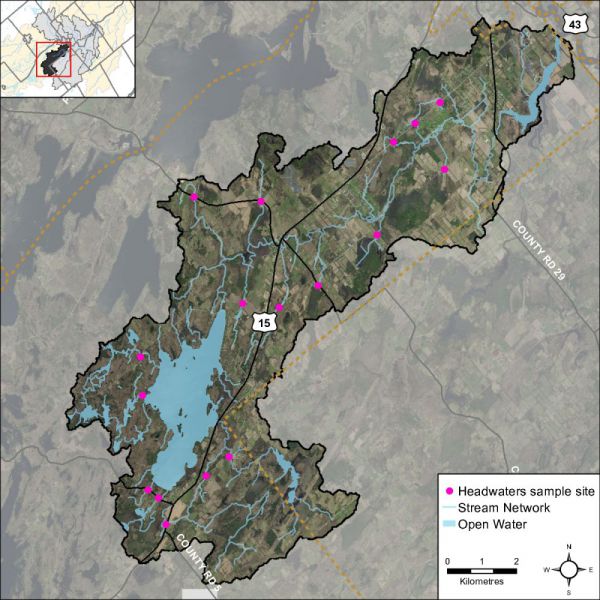
Figure 67 Locations of the headwater sampling sites in the Otter Creek catchment
Spring photo of a headwater drainage feature along Bass Road in the Otter Creek catchment
Summer photo of a headwater drainage feature along Bass Road in the Otter Creek catchment
Headwater Feature Type
The headwater sampling protocol assesses the feature type in order to understand the function of each feature. The evaluation includes the following classifications: defined natural channel, channelized or constrained, multi-thread, no defined feature, tiled, wetland, swale, roadside ditch and pond outlet. By assessing the values associated with the headwater drainage features in the catchment area we can understand the ecosystem services that they provide to the watershed in the form of hydrology, sediment transport, and aquatic and terrestrial functions. The Otter Creek catchment is dominated by natural channel and wetland headwater drainage features. Figure 68 shows the feature type of the primary feature at the sampling locations.
Figure 68 Headwater feature type in Otter Creek
Headwater Feature Flow
The observed flow condition within headwater drainage features can be highly variable depending on timing relative to the spring freshet, recent rainfall, soil moisture, etc. Flow conditions are assessed in the spring and in the summer to determine if features are perennial and flow year round, if they are intermittent and dry up during the summer months or if they are ephemeral systems that do not flow regularly and generally respond to specific rainstorm events or snowmelt. Flow conditions in headwater systems can change from year to year depending on location precipitation patterns. Figure 69 shows the observed flow conditions at the sampling locations in the Otter Creek catchment.
Figure 69 headwater flow type in Otter Creek
Headwater Feature Channel Modifications
Channel modifications were assessed at each headwater drainage feature sampling location. Modifications include channelization, dredging, hardening and realignments. The sampling locations for the Otter Creek catchment area were classified as having no channel modifications. Figure 70 shows the channel modifications observed at the sampling locations for Otter Creek.
Figure 70 headwater feature channel modifications in Otter Creek
Headwater Feature Vegetation
Headwater feature vegetation evaluates the type of vegetation that is found within the drainage feature. The type of vegetated within the channel influences the aquatic and terrestrial ecosystem values that the feature provides. For some types of headwater features the vegetation within the feature plays a very important role in flow and sediment movement and provides wildlife habitat. The following classifications are evaluated no vegetation, lawn, wetland, meadow, scrubland and forest. Figure 71 depicts the dominant vegetation observed at the sampled headwater sites in the Otter Creek catchment.
Figure 71 headwater feature vegetation types in Otter Creek
Headwater Feature Riparian Vegetation
Headwater riparian vegetation evaluates the type of vegetation that is found along the headwater drainage feature. The type of vegetation within the riparian corridor influences the aquatic and terrestrial ecosystem values that the feature provides to the watershed. The majority of the sample locations in Otter Creek were dominated by natural vegetation in the form of scrubland, forest and wetland vegetation. Figure 72 depicts the type of riparian vegetation observed at the sampled headwater sites in the Otter Creek catchment.
Figure 72 headwater feature riparian vegetation in Otter Creek
Headwater Feature Sediment Deposition
Assessing the amount of recent sediment deposited in a channel provides an index of the degree to which the feature could be transporting sediment to downstream reaches (OSAP, 2013). Evidence of excessive sediment deposition might indicate the requirement to follow up with more detailed targeted assessments upstream of the site location to identify potential best management practices to be implemented. Conditions ranged from no deposition observed to a site with substantial deposition recorded. Overall most sites had minimal to moderate levels of sediment deposition. Figure 73 depicts the degree of sediment deposition observed at the sampled headwater sites in the Otter Creek catchment.
Figure 73 Headwater feature sediment deposition in Otter Creek
Headwater Feature Upstream Roughness
Feature roughness will provide a measure of the amount of materials within the bankfull channel that could slow down the velocity of water flowing within the headwater feature (OSAP, 2013). Materials on the channel bottom that provide roughness include vegetation, woody debris and boulders/cobble substrates. Roughness can provide benefits in mitigating downstream erosion on the headwater drainage feature and the receiving watercourse by reducing velocities. Roughness also provides important habitat conditions to aquatic organisms. The majority of the sample locations in the Otter Creek catchment area had extreme to high levels of feature roughness. Figure 74 shows the feature roughness conditions at the sampling locations in the Otter Creek catchment.
Figure 74 Headwater feature upstream roughness in Otter Creek
Fish Community
The Otter Creek catchment is classified as a mixed community of warm and cool water recreational and baitfish fishery with 25 species observed. Table 15 lists the species observed in the catchment (Source: MNR/RVCA). Figure 75 shows the sampling locations along Rideau Creek.
Figure 75 Fish species observed in the Otter Creek catchment
Table 15 Fish species observed in Otter Creek and Otter Lake
Northern Pike captured and released along Otter Creek
Fyke net set along Otter Creek
Migratory Obstructions
It is important to know locations of migratory obstructions because these can prevent fish from accessing important spawning and rearing habitat. Migratory obstructions can be natural or manmade, and they can be permanent or seasonal. Figure 76 shows that on Otter Creek, the migratory obstructions included seven beaver dams, one debris jam and two perched culverts at the time of the survey in 2014.
Figure 76 Migratory obstructions observed in the Otter Creek catchment
Riparian Restoration
Figure 77 depicts the locations where various riparian restoration activities can be implemented as a result of observations made during the stream survey and headwater drainage feature assessments. Several riparian planting opportunities were identified on surveyed headwater drainage features.
Figure 77 Riparian restoration opportunities identified for the Otter Creek catchment
4. Land Cover
Land cover and any change in coverage that has occurred over a six year period is summarized for the Otter Lake and Creek catchment using spatially continuous vector data representing the catchment during the spring of 2008 and 2014. This dataset was developed by the RVCA through heads-up digitization of 20cm DRAPE ortho-imagery at a 1:4000 scale and details the surrounding landscape using 10 land cover classes.
As shown in Table 16, the dominant land cover types in 2008 and 2014 were woodland and crop and pastureland, followed by wetland.
Table 16 Land cover (2008 vs. 2014) in the Otter Lake and Creek catchment
* Does not include treed swamps ** Includes treed swamps
From 2008 to 2014, there was an overall change of 138 hectares (from one land cover class to another), the majority of which can be attributed to the conversion of “crop and pasture” and “woodland” to “settlement” (likely associated with new solar farms) along with “woodland” to “wetland” encroachment in southern areas of the catchment (see Figure 78 for the location of the major changes).
Figure 78 Dominant land cover change in the catchment (2008 to 2014)
Table 17 shows the type of land cover change that has taken place between land cover classes/types from 2008 to 2016. Overall, the net area of woodland change (loss) is relatively small at 73 hectares relative to the remaining area of woodland in the catchment (as of 2014). Similarlyl the net area of crop and pastureland change (loss) is small at 53 hectares relative to the remaining area of crop and pastureland in the catchment (as of 2014).
Table 17 Land cover change in the Otter Lake and Creek catchment (2008-2014)
Woodland Cover
In the Environment Canada Guideline (Third Edition) entitled “How Much Habitat Is Enough?” (here after referred to as the “Guideline”) the opening narrative under the Forest Habitat Guidelines section states that prior to European settlement, forest was the predominant habitat in the Mixedwood Plains ecozone. The remnants of this once vast forest now exist in a fragmented state in many areas (including the Rideau Valley watershed) with woodland patches of various sizes distributed across the settled landscape along with higher levels of forest cover associated with features such as the Frontenac Axis (within the on-Shield areas of the Rideau Lakes and Tay River subwatersheds). The forest legacy, in terms of the many types of wildlife species found, overall species richness, ecological functions provided and ecosystem complexity is still evident in the patches and regional forest matrices (found in the Middle Rideau subwatershed and elsewhere in the Rideau Valley watershed). These ecological features are in addition to other influences which forests have on water quality and stream hydrology including reducing soil erosion, producing oxygen, storing carbon along with many other ecological services that are essential not only for wildlife but for human well-being.
The Guideline also notes that forests provide a great many habitat niches that are in turn occupied by a great diversity of plant and animal species. They provide food, water and shelter for these species - whether they are breeding and resident locally or using forest cover to help them move across the landscape. This diversity of species includes many that are considered to be species at risk. Furthermore, from a wildlife perspective, there is increasing evidence that the total forest cover in a given area is a major predictor of the persistence and size of bird populations, and it is possible or perhaps likely that this pattern extends to other flora and fauna groups. The overall effect of a decrease in forest cover on birds in fragmented landscapes is that certain species disappear and many of the remaining ones become rare, or fail to reproduce, while species adapted to more open and successional habitats, as well as those that are more tolerant to human-induced disturbances in general, are able to persist and in some cases thrive. Species with specialized-habitat requirements are most likely to be adversely affected. The overall pattern of distribution of forest cover, the shape, area and juxtaposition of remaining forest patches and the quality of forest cover also play major roles in determining how valuable forests will be to wildlife and people alike.
The current science generally supports minimum forest habitat requirements between 30 and 50 percent with some limited evidence that the upper limit may be even higher, depending on the organism/species phenomenon under investigation or land-use/resource management planning regime being considered/used.
As shown in Figure 79, 35 percent of the Otter Lake and Creek catchment contains 2682 hectares of upland forest and 443 hectares of lowland forest (treed swamps) versus the 34 percent of woodland cover in the Middle Rideau subwatershed. This is greater than the 30 percent of forest cover that is identified as the minimum threshold required to sustain forest birds according to the Guideline and which may only support less than one half of potential species richness and marginally healthy aquatic systems. When forest cover drops below 30 percent, forest birds tend to disappear as breeders across the landscape.
Figure 79 Woodland cover and interior interior (2014)
Woodland (Patch) Size
According to the Ministry of Natural Resources’ Natural Heritage Reference Manual (Second Edition), larger woodlands are more likely to contain a greater diversity of plant and animal species and communities than smaller woodlands and have a greater relative importance for mobile animal species such as forest birds.
Bigger forests often provide a different type of habitat. Many forest birds breed far more successfully in larger forests than they do in smaller woodlots and some rely heavily on forest interior conditions. Populations are often healthier in regions with more forest cover and where forest fragments are grouped closely together or connected by corridors of natural habitat. Small forests support small numbers of wildlife. Some species are “area-sensitive” and tend not to inhabit small woodlands, regardless of forest interior conditions. Fragmented habitat also isolates local populations, especially small mammals, amphibians and reptiles with limited mobility. This reduces the healthy mixing of genetic traits that helps populations survive over the long run (Conserving the Forest Interior. Ontario Extension Notes, 2000).
The Environment Canada Guideline also notes that for forest plants that do not disperse broadly or quickly, preservation of some relatively undisturbed large forest patches is needed to sustain them because of their restricted dispersal abilities and specialized habitat requirements and to ensure continued seed or propagation sources for restored or regenerating areas nearby.
The Natural Heritage Reference Manual continues by stating that a larger size also allows woodlands to support more resilient nutrient cycles and food webs and to be big enough to permit different and important successional stages to co-exist. Small, isolated woodlands are more susceptible to the effects of blowdown, drought, disease, insect infestations, and invasions by predators and non-indigenous plants. It is also known that the viability of woodland wildlife depends not only on the characteristics of the woodland in which they reside, but also on the characteristics of the surrounding landscape where the woodland is situated. Additionally, the percentage of forest cover in the surrounding landscape, the presence of ecological barriers such as roads, the ability of various species to cross the matrix surrounding the woodland and the proximity of adjacent habitats interact with woodland size in influencing the species assemblage within a woodland.
In the Otter Lake and Creek catchment (in 2014), one hundred and twenty seven (37 percent) of the 346 woodland patches are very small, being less than one hectare in size. Another 199 (57 percent) of the woodland patches ranging from one to less than 20 hectares in size tend to be dominated by edge-tolerant bird species. The remaining 20 (six percent of) woodland patches range between 22 and 492 hectares in size. Fourteen of these patches contain woodland between 20 and 100 hectares and may support a few area-sensitive species and some edge intolerant species, but will be dominated by edge tolerant species.
Conversely, six (two percent) of the 346 woodland patches in the drainage area exceed the 100 plus hectare size needed to support most forest dependent, area sensitive birds and are large enough to support approximately 60 percent of edge-intolerant species. Three of these patches top 200 hectares (at 242, 362 and 492 ha), which according to the Environment Canada Guideline will support 80 percent of edge-intolerant forest bird species (including most area sensitive species) that prefer interior forest habitat conditions.
Table 18 presents a comparison of woodland patch size in 2008 and 2014 along with any changes that have occurred over that time. A decrease (of 64 ha) has been observed in the overall woodland patch area between the two reporting periods with most change occurring in the 20 to 50 hectare woodland patch size class range.
Table 18 Woodland Patches in the Otter Lake and Creek Catchment (2008 and 2014)
*Includes treed swamps
Woodland (Forest) Interior Habitat
The forest interior is habitat deep within woodlands. It is a sheltered, secluded environment away from the influence of forest edges and open habitats. Some people call it the “core” or the “heart” of a woodland. The presence of forest interior is a good sign of woodland health, and is directly related to the woodland’s size and shape. Large woodlands with round or square outlines have the greatest amount of forest interior. Small, narrow woodlands may have no forest interior conditions at all. Forest interior habitat is a remnant natural environment, reminiscent of the extensive, continuous forests of the past. This increasingly rare forest habitat is now a refuge for certain forest-dependent wildlife; they simply must have it to survive and thrive in a fragmented forest landscape (Conserving the Forest Interior. Ontario Extension Notes, 2000).
The Natural Heritage Reference Manual states that woodland interior habitat is usually defined as habitat more than 100 metres from the edge of the woodland and provides for relative seclusion from outside influences along with a moister, more sheltered and productive forest habitat for certain area sensitive species. Woodlands with interior habitat have centres that are more clearly buffered against the edge effects of agricultural activities or more harmful urban activities than those without.
In the Otter Lake and Creek catchment (in 2014), the 346 woodland patches contain 95 forest interior patches (Figure 79) that occupy three percent (295 ha.) of the catchment land area (versus the five percent of interior forest in the Middle Rideau Subwatershed). This is below the ten percent figure referred to in the Environment Canada Guideline that is considered to be the minimum threshold for supporting edge intolerant bird species and other forest dwelling species in the landscape.
Most patches (91) have less than 10 hectares of interior forest, 59 of which have small areas of interior forest habitat less than one hectare in size. The remaining four patches contain interior forest ranging between 10 and 66 hectares in area.
Between 2008 and 2014, there has been a change in the number of woodland patches containing smaller areas of interior habitat (Table xx). For example, there has been an increase of 41 woodlands containing less than one hectare of interior forest over this period and 18 woodlands with one to 10 hectares of interior habitat.
Table 19 Woodland Interior in the Otter Lake and Creek catchment (2008 and 2014)
Wetland Cover
Wetlands are habitats forming the interface between aquatic and terrestrial systems. They are among the most productive and biologically diverse habitats on the planet. By the 1980s, according to the Natural Heritage Reference Manual, 68 percent of the original wetlands south of the Precambrian Shield in Ontario had been lost through encroachment, land clearance, drainage and filling.
Wetlands perform a number of important ecological and hydrological functions and provide an array of social and economic benefits that society values. Maintaining wetland cover in a watershed provides many ecological, economic, hydrological and social benefits that are listed in the Reference Manual and which may include:
- contributing to the stabilization of shorelines and to the reduction of erosion damage through the mitigation of water flow and soil binding by plant roots
- mitigating surface water flow by storing water during periods of peak flow (such as spring snowmelt and heavy rainfall events) and releasing water during periods of low flow (this mitigation of water flow also contributes to a reduction of flood damage)
- contributing to an improved water quality through the trapping of sediments, the removal and/or retention of excess nutrients, the immobilization and/or degradation of contaminants and the removal of bacteria
- providing renewable harvesting of timber, fuel wood, fish, wildlife and wild rice
- contributing to a stable, long-term water supply in areas of groundwater recharge and discharge
- providing a high diversity of habitats that support a wide variety of plants and animals
- acting as “carbon sinks” making a significant contribution to carbon storage
- providing opportunities for recreation, education, research and tourism
Historically, the overall wetland coverage within the Great Lakes basin exceeded 10 percent, but there was significant variability among watersheds and jurisdictions, as stated in the Environment Canada Guideline. In the Rideau Valley Watershed, it has been estimated that pre-settlement wetland cover averaged 35 percent using information provided by Ducks Unlimited Canada (2010) versus the 21 percent of wetland cover existing in 2014 derived from DRAPE imagery analysis.
While there has been a reported three percent decrease in wetland cover in the Otter Lake and Creek catchment from pre-settlement times, the remaining wetland cover in 2014 remains above the ecological thresholds cited in the Environment Canada Guideline. Nonetheless, in order to maintain critical hydrological, ecological functions along with related recreational and economic benefits provided by these wetland habitats in the catchment, a “no net loss” of currently existing wetlands should be employed to ensure the continued provision of tangible benefits accruing from them for landowners and surrounding communities.
Using the same dataset, it is estimated that pre-settlement (historic) wetland cover averaged 32 percent in the Middle Rideau subwatershed versus the 27 percent of cover existing in 2014. This decline in wetland cover is also evident in the Otter Lake and Creek catchment (as seen in Figure 80) where there has been a three percent decrease in the area of wetland cover from pre-settlement times to the present (as summarized in Table 20).
Figure 80 Wetland cover (pre-settlement to 2014)
While there has been a reported decrease in wetland cover in the Otter Lake and Creek catchment from pre-settlement times, the remaining wetland cover in 2014 remains above the ecological thresholds cited in the Environment Canada Guideline. Nonetheless, in order to maintain critical hydrological, ecological functions along with related recreational and economic benefits provided by these wetland habitats in the catchment, a “no net loss” of currently existing wetlands should be employed to ensure the continued provision of tangible benefits accruing from them for landowners and surrounding communities.
Table 20 Wetland cover in the Middle Rideau subwatershed and Otter Lake and Creek catchment (Historic to 2014)
5. Stewardship and Protection
The RVCA and its partners are working to protect and enhance environmental conditions in the Middle Rideau Subwatershed. Figure 81 shows the location of all stewardship projects completed in the Otter Lake and Creek catchment along with sites identified for potential shoreline restoration.
Rural Clean Water Projects
From 2009 to 2014, six septic system replacements and one erosion control project were completed. Between 2003 and 2008, 10 well upgrades, four septic system replacements, one well decommissioning, one erosion control project and one education initiative were carried out along with construction of one fuel storage and handling facility. Prior to 2003, two livestock fencing projects and one septic system replacement were completed. Total value of all 28 projects is $215,494 with $96,685 of that amount funded through grant dollars from the RVCA.
Figure 81 Stewardship and restoration locations
Tree Planting Projects
The location of RVCA Tree Planting Program projects is shown in Figure 81. From 2009 to 2014, 7,082 trees were planted at four sites. Between 2003 and 2008, 1,000 trees were planted at one site and prior to 2003, 12,750 trees were planted at three sites, resulting in the reforestation of 13 hectares. Total value of all eight projects is $62,019 with $22,285 of that amount coming from various fundraising sources.
Through the RVCA Butternut Recovery Program, an additional 110 butternut trees were planted in the Otter Lake and Creek catchment, as part of efforts to introduce healthy seedlings from tolerant butternuts into various locations across Eastern Ontario.
Septic System Re-Inspections
From 2007 to 2015, the Mississippi Rideau Septic System Office performed 66 septic system re-inspections (52 cottages and 14 houses) on Otter Lake in Rideau Lakes Township. Remedial/maintenance work (i.e. pump outs, baffle replacement, work that generally does not require a permit) was recommended for 41 (or 62 percent) of those properties that were inspected, septic system replacements at two properties with more information provided to two other landowners with identified septic system concerns. No specific concerns were noted for the other 21 septic systems that were inspected.
Valley, Stream, Wetland and Hazard Land Regulation
The Otter Lake and Creek catchment covers 89 square kilometres with 37 square kilometres (or 42 percent) of the drainage area being within the regulation limit of Ontario Regulation 174/06 (Fig. 82), giving protection to wetland areas and river or stream valleys that are affected by flooding and erosion hazards.
Wetlands occupy 19.2 sq. km. (or 21 percent) of the catchment. Of these wetlands, 14.5 sq. km (or 76 percent) are designated as provincially significant and included within the RVCA regulation limit. This leaves the remaining 4.7 sq. km (or 24 percent) of wetlands in the catchment outside the regulated area limit.
Of the 137.4 kilometres of stream in the catchment, regulation limit mapping has been plotted along 95.8 kilometers of streams (representing 70 percent of all streams in the catchment). Some of these regulated watercourses (73.1 km or 53 percent of all streams) flow through regulated wetlands; the remaining 22.6 km (or 24 percent) of regulated streams are located outside of those wetlands. Plotting of the regulation limit on the remaining 41.6 km (or 30 percent) of streams requires identification of flood and erosion hazards and valley systems.
Within the regulation limit, “development” and “site alteration” require RVCA permission. The “alteration to waterways” provision of Ontario Regulation 174/06 applies to all watercourses.
Figure 82 RVCA regulation limits
Vulnerable Drinking Water Areas
The Otter Lake and Creek catchment area is considered to have a Highly Vulnerable Aquifer. This means that the nature of the overburden (thin soils, fractured bedrock) does not provide a high level of protection for the underlying groundwater making the aquifer more vulnerable to contaminants released on the surface. The Mississippi-Rideau Source Protection Plan includes policies that focus on the protection of groundwater region-wide due to the fact that most of the region, which encompasses the Mississippi and Rideau watersheds is considered Highly Vulnerable Aquifer.
The catchment area to the south and east of Otter Lake is also considered a Significant Groundwater Recharge Area. This means that there is a volume of water moving from the surface into the ground and groundwater serves either as a municipal drinking water source or supplies a lake or stream ecosystem. The Plan was not required to include policies to specifically address Significant Groundwater Recharge Areas.
For detailed maps and policies that have been developed to protect drinking water sources, please go to the Mississippi-Rideau Source Protection Region website at www.mrsourcewater.ca to view the Mississippi-Rideau Source Protection Plan.
6. Challenges/Issues
Water Quality
Otter Lake
- Otter Lake has a “Fair”’ surface chemistry water quality rating for the 2003 to 2008 and 2009 to 2014 periods and is generally characterized by moderate nutrient concentrations
- Forty-three (of 66) Rideau Lakes Township septic system voluntary re-inspections conducted from 2007 to 2015 revealed the need for additional maintenance/remedial/replacement works to be performed on septic systems around Otter Lake. Those properties with concerns are identified in the yearly report submitted by the Mississippi Rideau Septic System Office to the Township
- RVCA’s 2013 Algae and Aquatic Plant Survey for Eastern Ontario Lakes and Rivers notes that three of five respondents from Otter Lake have noticed an increase in algae blooms on their lake
Otter Creek
- Otter Creek has a "Fair" surface chemistry water quality rating for the 2003 to 2008 and 2009 to 2014 periods. Frequent exceedances of total phosphorous, total Kjeldhal nitrogen and E.coli and occasional exceedances of ammonia, aluminum and iron have contributed to the Creek’s overall rating
- Otter Creek has a “Poor” benthic invertebrate (biological) water quality rating from 2003 to 2014
Development
- Most development in the catchment is occurring on waterfront properties through the transformation of traditional cottage development into larger year-round dwellings. This transition is taking place either through re-development of an existing cottage lot or incremental alterations (additions, sleeping cabins, gazebos, decks, sheds, boat houses, garages, lawns, docks)
- Many waterfront properties contain existing non-complying dwellings with respect to minimum water frontage and lot area and are often located within 30 metres of the water that require minor variances for expansion and/or reconstruction of dwellings where standard development setbacks from water are difficult to achieve. In these cases, of which there are many, staff at Rideau Lakes Township and the Conservation Authority often meet with resistance and push back when attempts are made to implement standards for development setbacks, vegetated shorelines and septic systems
- Monitoring implementation of conditions of planning and regulatory approvals is challenging due to a lack of resources
Shorelines
- Around Otter Lake in 2014, the 30 metre wide shoreline buffer contains (55 percent) non-natural land cover (comprised of waterfront cottages, houses, camps and roads) and 45 percent natural land cover (made up of wetland and woodland), which is below the recommended 75 percent naturally vegetated riparian, shoreline buffer target. Otter Lake has experienced a six percent increase in the area of settlement along its shoreline over a six year period
- Emerald ash borer poses a significant threat to the ecology of the subwatershed, given the prominence of ash trees along shorelines and in riparian and wetland areas. Many tree stands are predominantly ash and with their anticipated loss, it is unclear what will replace them and the overall effect of their collective demise on the physical and natural functions/values they provide for erosion, water quality and fish and wildlife habitat protection
Land Cover
- The catchment contains 469 ha of unevaluated wetland (occupying five percent of its total area) that provides many important social, hydrological, biological and ecological functions/services. Although not under imminent threat from development activity, they do remain vulnerable to drainage and land clearing activities in the absence of any regulatory and planning controls that would otherwise protect them
Water Levels
- Management of water levels on Otter Lake continues to be a source of concern for waterfront property owners; particularly, flooding in the spring and late fall and the lack of adequate drainage at its outlet to Otter Creek
Aquatic Habitat/Fisheries
- Littoral zone mapping identifying substrate type, vegetation and habitat features along with opportunities for shoreline enhancements is unavailable for Otter Lake
Prepared by the Otter Lake Landowners’ Association and its partners, the Otter Lake Sustainable Lake Plan (2015) outlines eight goals, 19 objectives and 79 action items identified by the lake community to maintain and improve the health of the Otter Lake watershed.
The following section includes some of those identified action items taken from that document (as identified by an asterisk), which have implications for the sustainable use and management of the water resources of Otter Lake and RVCA’s monitoring, reporting, planning/regulations and stewardship programs. Refer to the Otter Lake Sustainable Lake Plan for a complete list of all actions listed in that document.
7. Opportunities/Actions
Water Quality
- Continue to monitor E. coli, Nitrogen and Phosphorous levels in Otter Lake in conjunction with the RVCA and seek no net increase in their levels over time. Aim for the OLLA target of: less than 5 CFU/100ml for E.coli; less than 10 micrograms for Phosphorous and between 200 to 500 µg/L for Nitrogen and report surface water quality results back to the Otter Lake community*
- Consider expansion of surface water quality testing to include periodic sampling of the in/outflow creeks of Otter Lake*
- Review RVCA Watershed Watch monitoring of surface water quality on Otter Lake
- Continue to promote the voluntary septic system re-inspection program that the Township of Rideau Lakes introduced in 2007*
- Work with the Township of Rideau Lakes to establish a mandatory sewage system inspection program on Otter Lake with an associated educational program and seek funding to provide financial assistance to landowners for repair or upgrades to their systems*
- Continue to offer septic repair/replacement project funding provided by the Rideau Valley Rural Clean Water Program to landowners
- Educate the Otter Lake community about septic system care by providing information about sewage system maintenance (i.e., when to pump out septic systems and holding talks)
- Continue efforts to reduce pollutant loadings to Otter Lake through education about the application of shoreline, stormwater and agricultural best management practices; also consider using low impact development (LID) methods to improve the quality and reduce the amount of stormwater runoff reaching the lake ecosystem. This may be particularly beneficial in areas with extensive impervious surfaces (i.e., asphalt, concrete, buildings, and severely compacted soils) or on sensitive waterfront properties (with steep slopes/banks, shallow/impermeable soils)
- Continue efforts to identify pollution sources along Otter Creek that may be contributing to the poor benthic invertebrate rating and reduce the frequently high nutrient concentrations and bacterial counts and occasional metal exceedances through ongoing monitoring and implementation of best management practices such as diverting runoff, enhancing shoreline buffers, limiting the use of fertilizers and pesticide applications and restricting livestock access
- Continue to promote the protection of the water resources of Otter Lake and Creek and its tributaries through implementation of municipal and agency land use planning and development policies and practices
Development
- Collectively work with approval authorities (Township of Rideau Lakes, Conservation Authority, the Health Unit and Mississippi-Rideau Septic System Office) and the Otter Lake Landowners’ Association to consistently implement current land use planning and development policies for water quality and shoreline protection adjacent to Otter Lake and Creek and other catchment streams (e.g., a minimum 30 metre development setback from water)
- Explore ways and means to more effectively enforce and implement conditions of land-use planning and development approval to achieve net environmental gains (particularly with respect to rehabilitating or protecting naturally vegetated shorelines and water quality)
- Encourage Committees of Adjustment to take advantage of technical and environmental information and recommendations forthcoming from planning and environmental professionals
- Municipalities and agencies are encouraged to strengthen natural heritage and water resources official plan policies and zoning provisions (water setbacks, frontage and naturalized shorelines and wetland protection) where deemed appropriate
- Municipal and agency planners together with development proponents are to use the 2014 Site Evaluation Guidelines to inform decision-making about the application of development setbacks on lots with shallow soils/bedrock, steep slopes and sparse vegetation cover along with the use of the appropriate, development related, best management practices
- Utilize RVCA subwatershed and catchment reports to help develop/revise official plan policies to protect surface water resources and the natural environment (including woodlands, wetlands and shoreline cover)
- Consider establishing RVCA regulations limits to protect additional wetlands
Shorelines
- Provide property owners with an assessment of the condition of their shoreline and recommendations for improvement using the results of the 2015 Otter Lake Shoreline Assessment*
- Partner with the RVCA to promote its Shoreline Naturalization Program to re-naturalize altered shoreline*
- RVCA and its partners (Rideau Lakes Township and the Otter Lake Landowners’ Association) are to continue educating landowners about the value and importance of headwater drainage features, natural shorelines and waterfront property best management practices with respect to shoreline use and development, septic system installation and maintenance and shoreline vegetation retention and enhancement
- Protect the riparian buffer along the shoreline of Otter Lake and Otter Creek and other catchment streams (headwaters) during the development approvals process through adherence to and enforcement of municipal land-use policies and zoning standards
- Target shoreline restoration at sites identified in this report (shown as “Other riparian land cover” in Figure 38 and “Potential Riparian/Shoreline Restoration” in Figure 77) and explore other restoration and enhancement opportunities along Otter Creek and its tribuatries
Water Levels
- Establish a standard water level monitoring location on Otter Lake along with a “benchmark” water level and the authority responsible for measurements and continue with water level monitoring and reporting to the community*
- Continue to leave to the forces of nature the natural flow of water into and out of Otter Lake, except in the case of expected high spring water levels, in which case the help of the RVCA and the Otter Creek Beaver Management Group may be needed to lower the beaver dams to increase the outflow of water through Otter Creek*
- Communicate to the lake community any water level actions taken by the Beaver Management Group*
- Continue to monitor if there is a need for greater water out flow capacity from Otter Lake than is currently provided by the existing culvert under the Otter Lake Road*
Aquatic Plants
- Establish a volunteer-based aquatic invasive species (AIS) monitoring program and participate in the AIS Monitoring System to assist with early detection and management
- Provide information about aquatic invasive species and the pathways for introduction along with AIS signage at the boat launch area off Highway 15*
Aquatic Habitat/Fisheries/wildlife
- Request the Ministry of Natural Resources and Forestry to conduct a fish population assessment for Otter Lake*
- Evaluate the littoral zone of Otter Lake identifying opportunities for shoreline enhancements to help protect and enhance the resident fish population and its aquatic habitat
- Educate Otter Lake shoreline owners and visitors about fish habitat requirements, spawning schedules and near-shore and in-water activities that can disturb or destroy fish habitat and spawning sites, as well as the importance of re/naturalized shorelines*
- Educate Otter Lake shoreline residents about best management practices to deal with species such as Canada Geese (e.g. replace grassy areas with native ground cover and shrubs)*
Lake Planning
- Implement on a priority basis the identified actions listed in the Otter Lake Sustainable Lake Plan
Full Catchment Report
